Graham Leslie McCallum
The tree of happiness flowers and fruits most abundantly for the creative man
ICONIC THEMES – THE CAPE WAGON – A PICTORIAL TREK
The South African historic image is arguably the oldest of any country. Within the activities of homo-sapiens – one has only to look at the artefacts unearthed by Archaeologists across the face of Southern Africa. Just 40 kilometres from where I sit writing this post in the city of Durban, is ‘Sibudu‘, a sandstone cliff shelter near the village of Tongaat. Here, artefacts like the world’s oldest sewing needle and bone arrow-heads (61 000 years old) were discovered.
(below) Shell, bone and stone implements found in the Sibudu Shelter.
Among the many extraordinary artefacts discovered are numerous stone tools, the kind we are all familiar with, the kind that have become synonymous with ancient man and the Stone Age.
Artefacts such as these have the ability to become iconic stand-ins for cultures, epochs and peoples. Just as the awe-inspiring San rock paintings and stone-engravings do in Southern Africa – as representatives for a people reduced, for a culture no more, as reminders for us to preserve our past, as entreaties to bestow dignity on all men.
As an Artist and Designer, iconic images hold especial interest and fascination. While researching my books and posts I often come across new iconic imagery, some so ingrained in our collective experience as to be sometimes overlooked. In our Western Culture, angels in one form or another seldom occasion us to pause. However, some painter, potter, craftsman or story-teller, at some initial point in history, attached a pair of wings to a man – and the idea and image spread around the globe. At ground-level, winged-men are indicative of mankind’s envy of all flying creatures; but in elevated-thinking – angels represent our desire to befriend our Maker.
While researching the ox-drawn Cape-wagon, I was surprised by the of the vast number of drawings, engravings and paintings created by Artists, Travellers, Explorers and Naturalists of Cape-wagons over the past 300 years. It was as if the wagon (like Table Mountain, a Zulu Bee-hive hut and a Baobab tree) had become a symbolic ‘stand-in’ for South Africa.
The wagon had become symbolic of exploration, adventure and new horizons; the freedom of the wide African landscape and the big sky; the anticipated relaxation of outspanning at the end of a long day’s trek and a night of camaraderie around a fire at night. I write of just such a South African iconic-theme – that of the ‘Outspan’ in my blog posting https://grahamlesliemccallum.wordpress.com/2014/07/18/outspanning/
Further to the wagon becoming a symbol – certain activities involving wagon-trekking took hold of the traveller’s imagination in several often-encountered themes. A fine example of an iconic-theme are all the numerous images of ox-wagons fording rivers. It is evident that river-crossings (their difficulty, danger, clamour, splashing and slipping) – made indelible impressions on the minds of everyone who visited or who lived at the Cape. And – thanks to Artist and Author – we know this. It also made a strong impression on the minds of Illustrators and Book Printers back in Europe. No Explorer or Missionary’s book was complete without a picture of that baptism by water. The iconic-theme of the ‘river-crossing’ thus becomes symbolic of the great South African adventure and way of life.
In this posting – like those 17th, 18th and 19th century wanderers, I explore these iconic pictorial themes. Perhaps as you scroll through the many historic images, you will slow your pace to that of the shambling ox, perhaps sojourn just long-enough to outspan, and maybe in so doing – feel the excitement of the trek -and in so doing – remember and honour all those who once lived and loved the veldt and berg.
THEME 1 – FORDING THE RIVER
(above) A painting by the Artist and Explorer Thomas Baines of his Cape-wagon crossing a stream in Natal. Note that this wagon is painted in the traditional colours of red and green. On the banks is a wild-banana (Strelizia nicolai) – symbolic to me (and many) of my home province – Natal.
(above) An engraving of three transport wagons being drawn through a shallow drift. The waggoneer behind the last wagon is applying the screw brakes to slow the descent. These brakes supplanted the earlier skidpan (remskoen) that was placed under the rear wheels.
(above) A fascinating and dramatic painting by Explorer and Government-Surveyor Charles Bell of a Cape-wagon crossing a mountain stream. Two Khoikhoi drivers attempt to anchor the wagon by ropes from toppling into the kloof and pulling the oxen to their deaths; while another stands ready with his whip to encourage the oxen to greater exertion. In situations like this, it was necessary for the ‘voorloper’ to lead the oxen along the best path. 1842.
(above) An engraving of a ‘voorloper’ (front-walker) leading a span of oxen across a drift. Often two wagons would be hitched-together if enough oxen could be spanned together, or if the drift was an easy one.
(above) An ink-drawing of a span of oxen drawing a large buck-wagon up the bank of a river. The strongest and most intelligent of oxen were yoked in the position on either side of the shaft. It was their job to brake and turn the wagon. And yes – evidently some oxen are brighter than others.
(above) A painting of an ox-wagon crossing the Berg River, Cape. 1846. The Berg river flows to the north of Cape Town, and had to be forded on the road to the Wellington and Worcester.
(above) A drawing of an ox-wagon having just forded a river, with the towering Silver Mountain (Drakenstein Range) in the background, Cape. The granite of this mountain sparkles with mica inclusions. In the foreground is the upper reaches of the Berg River.
(above) A remarkably clear and detailed photograph of a wagon fording a river.
(above) A painting of a team of oxen pulling a wagon through the Limpopo River, the riverine-border between the Transvaal and Rhodesia. One often get the impression that the weary trek-oxen looked forward to these periodic dips, to cool-down and quench thier thirsts. Of course – if the river was deep and in flood, this would not be the case.
(above) A photograph of oxen pulling a Cape-wagon through a river, while travellers watch from the safety of the bank. Note one individual in undress and another attempting to assist the oxen. A river with a rock-strewn bottom would have created untold hazards to oxen and wagon. Travellers would as a rule, cross rivers at known drifts. These drifts were generally given the name of a local farmer or the name of a farm.
(above) A transport-wagon with tilt (kaptent) crossing at a drift. If the drift afforded an easy crossing, the oxen would pause midstream for a cooling drink.
(above) A photograph of a wagon fording a stream while surrounded by thick riverine vegetation. Note the face peering from the reeds to the immediate right of the ‘voorloper’.
(above) A transport wagon crossing the Umvoti River (Mvoti), Natal. Note how earlier travellers have pushed large boulders out of the path of the wagons.
(above) A drawing by Artist – A. Simes, of a transport-wagon crossing a drift.
(above and below) A photograph of a span of sixteen oxen about to draw a transport-wagon through a river, Drakensberg foothills, Natal.
(above) An ox-wagon crossing a river in Natal.
(above) An engraving of a wagon crossing a drift in Natal. From the book – ‘Alone among the Zulus’ – by Charlotte Barter. 1878.
(above) A lithograph of Missionary and Durban Pioneer – Captain Allen Gardiner’s wagon crossing the Tugela River from Natal into Zululand. Gardiner visited King Shaka several times seeking to set up a mission station. Refused, he returned to the Bay of Natal and set up his Berea Mission amongst the resident black population and the white British settlers. Gardiner is thus the father to all Zulu Christians. https://grahamlesliemccallum.wordpress.com/2016/05/18/gardiner-street-durban/
(above) Photograph of two transport wagons crossing the Tugela River, Natal/ Zululand.
(above) A photograph of a buck-wagon crossing the Umlaas River near Durban, Natal.
(above) A photograph with the caption ‘travelling in Natal’. It appears as if the front wheels of the wagon have stuck fast forcing the women and children to alight.
(above) A sepia-toned photograph of a wagon fording a river near Durban, Natal.
(above) Photograph of ox-wagons crossing the Ingogo River drift, Northern Natal. This drift is close to the vicinity of the Battle of Ingogo, 1st Anglo-Boer War. https://grahamlesliemccallum.wordpress.com/2014/05/07/1523/
(above) A transport wagon with a tilt (kaptent) crossing the Incandu River Drift, (Ncandu) with the town of Newcastle in the background. Note how the oxen and wagons have worn down the banks. Note the small pontoon on the right.
https://grahamlesliemccallum.wordpress.com/2014/04/26/newcastle-natal/
(above) An engraving of a wagon crossing the Umgeni River north of Durban, Natal. This river is sizeable and would require the oxen to swim, something they could do with some agility.
(above) A Mission wagon crossing a river where it appears to have stuck midstream.
(above) A transport-wagon crossing a stream.
(above) A photograph of oxen pausing while crossing a small stream, as each yoke takes a turn quenching their thirst.
(above) A drawing of thirsty humans, dogs and cattle approaching a river in anticipation of a drink.
(above) An ox- wagon crossing a dry river-bed.
(above) A lithographic print of a wagon crossing at ‘Kayman’s Gat’ (Kaaimansgat) (Caiman/ Crocodile Hole) before making the ascent of the precipitous ‘Kayman’s Gat Pass’, near Plettenberg Bay, from a sketch by Melville, 1818. This wagon track can still be seen on Satelite images at the confluence of the Swart River and Kaaiman River 198 years after this image was made.
(above) An engraving of a train of wagons crossing the Orange River.
(above) British troops and a wagon crossing the broad Orange River, named after the Dutch – Prince of Orange.
(above) A painting by Thomas Baines of British and Colonial troops under the command of Lt. General Cathcart crossing the Orange River with their wagons to attack Moshesh, 1852. probably at the Norval’s Pont Drift. Before becoming an independent state, the area was known as Transorania.
(above) A drawing of wagons crossing a river to meet-up with a laager of wagons, 1835. Eastern Cape. Frontier Wars.
(above) British troops watch while a train of transport-wagons cross a drift during the Anglo-Boer War. 1899-1902. In the background one can observe a railway bridge destroyed by the retreating Boer forces.
(above) A photograph taken during the Anglo-Boer war of British military transport wagons crossing a river. Note the horse’s ear on the right of the image.
(above) An engraving of a wagon about to ford the Apies River, Pretoria.
(above) An engraving of the Missionary Moffat’s wagon been drawn through a river by locals.
(above) A photograph recording a loaded transport-wagon crossing a river.
(above) A fully-loaded transport wagon pauses while crossing a drift.
(above) A transport wagon been pulled across the Lundi River by three spans of oxen, Rhodesia.
(above) Drawing of several wagons fording the Lungi River, Rhodesia.
(above) An amusing drawing of wagons fording the Lungi River. Two gentlemen have waded-across. Rhodesia.
(above) A print of an ox-wagon fording a river.
(above) A hunter’s Cape-wagon crossing a stream. Note the lion skin atop the wagon tent and the unusual standards on the wagon. This image is more from the imagination of an Illustrator back in England who was given the work of translating the Author’s words into an image.
(above) A well-known painting by Thomas Baines of his oxen attempting to extricate his wagon from a drift on the Klaas Smit River. 1852. It appears as if the futchel of the wagon has lodged itself well and truly into the bank. A driver is attempting to get the two rear-oxen to back-up. Baines portrayed himself, unconcerned and sketching on the opposite bank. It is thanks to people like Baines, Burchell, Bell and Michell whose art and writings afford us a window into the past.
(above) A striking woodcut print from South African Author – Graham Greene’s book ‘In the Land of the Afternoon’ – of an ox-wagon fording a river.
(above) A photograph of a transport-wagon with women passengers crossing a rocky stream.
(above) A Cape-wagon crossing a South African drift.
(above) A print showing two wagons crossing a drift.
A painting by Charles Bell of a Cape-wagon crossing a stream.
(above) Wagons crossing the Shashi River.
(above) A train of ox-drawn wagons crossing a river.

(above) A wagon crossing a drift of the Crocodile River.
(above) A print taken from a painting by the Artist and Explorer Burchell of a wagon and oxen crossing the Berg River via a ferry on the road to the Koud Bokkeveld. If a river was too deep this might be the only way to cross until a river’s flow dropped. A ferry was maintained at Sand Drift on the road north from Cape Town. Heuningsberg can be seen in the background.
(above) A photograph of a wagon with full compliment of oxen still in their traces, been ferried across a river in the Cape.
(above) A wagon and cape-cart being ferried across a large river.
(above) A Boer family been ferried across a river with their transport-wagon.
(above) Photograph of a wagon and a span of oxen being ferried across the Vaal River.
(above) An engraving of a loaded British military wagon and ferry overturning on a strongly running Incandu River, Incandu River Drift, Newcastle, Natal. The Incandu has a reputation of coming-down in flood after heavy rains in the Drakensberg catchment. Anglo-Zulu War 1879.
(above) An engraving of British troops fording a River in Natal/Zululand, 1879.
(above) A photograph of a loaded transport wagon about to ford the river near Rietfontein.
(above) A wagon train crossing a river in the Eastern Cape, while soldiers provide cover by shooting on the Xhosa.
(above) British soldiers assisting a wagon and naval gun across the Tugela River. 2nd Anglo-Boer War.
(above) A photograph of an over-loaded transport wagon that has broken-down with a collapsed wheel. An exasperated man looks on as another ox-wagon’s descent is checked.
(above) A transport wagon with a heavy load of timber sinks down to its axle in the river mud near Pretoria. A situation such as this would require off-loading the wagon. If oxen were over-exerted, they would refuse to pull or lay-down in their traces, and not even a whip could move them. An experienced driver would know their limitations. A solution was to hitch two or three spans of oxen to wagon.
(above) A photograph of an overturned transport wagon during the Anglo-Boer War. This must have been a regular occurrence before bridges were built and roadways were hardened.
(An engraving of an ox-wagon ascending a steep river bank after having crossed a fast-flowing Umfuli River, Rhodesia.
(above) ‘Fore-spanning’ – a method of drawing an ox-wagon up a very steep river bank, by leaving the rear oxen attached in their usual positions, but unyoking two or three span of oxen so that the front spans of oxen can ascend the bank unhindered until they reach level ground where they can have better traction.
(above) An engraving of an ox-wagon crossing the Vaal River.
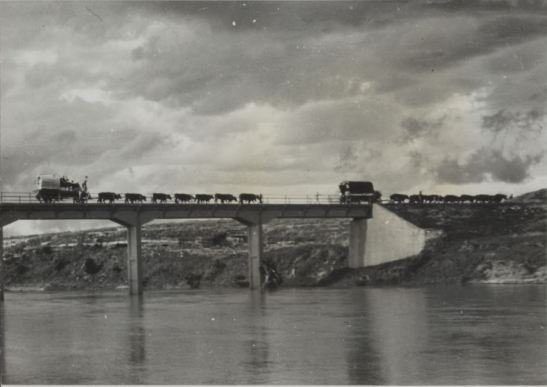
(above) The building of bridges across South African rivers from the 1880’s and onwards made for safer crossings and for less excitement.
……………………………………………………………………………………………………………
THEME 2. CROSSING THE MOUNTAIN PASS
(above and below) An iconic painting and engraving by Charles Michell of an ox-wagon ascending Cradock Pass, Outeniqua Mountains, Cape. 1840. Michell, a Surveyor and Road Builder used this image to illustrate the dangerous ascent. This image has captured the imagination of South Africans for many generations. It was used to illustrate numerous books on travel at the Cape, often transposed to other passes and mountains. One very similar image claims to be a wagon ascending a steep hill near the Umkomaas River in Natal. In the 20th Century Michell’s image was appropriated by nationalists to portray the Cape-Dutch farmers (later known as the Voortrekkers) crossing the Drakensberg.
(below) The appropriated engraving mentioned above of a wagon ascending a hill near Umkomaas.
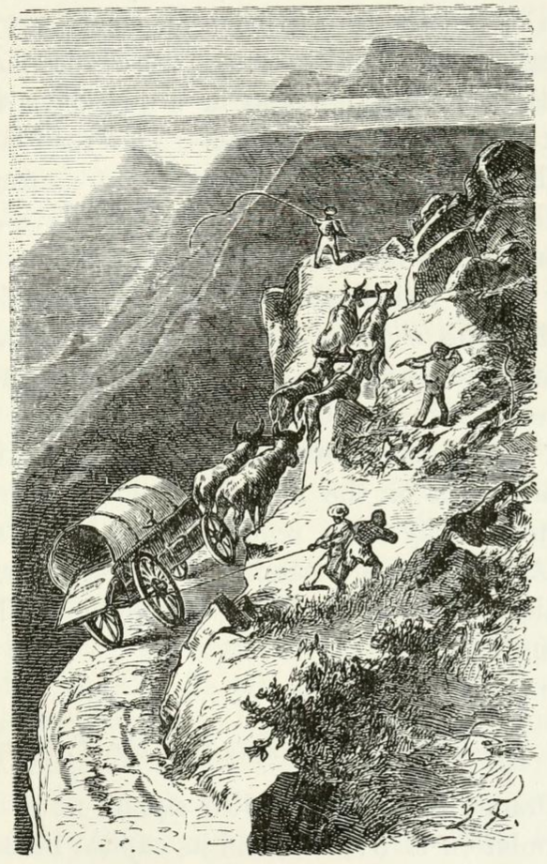
(below) Michell’s iconic image was used on this 1938 stamp to commemorate the Great Trek of 1838.
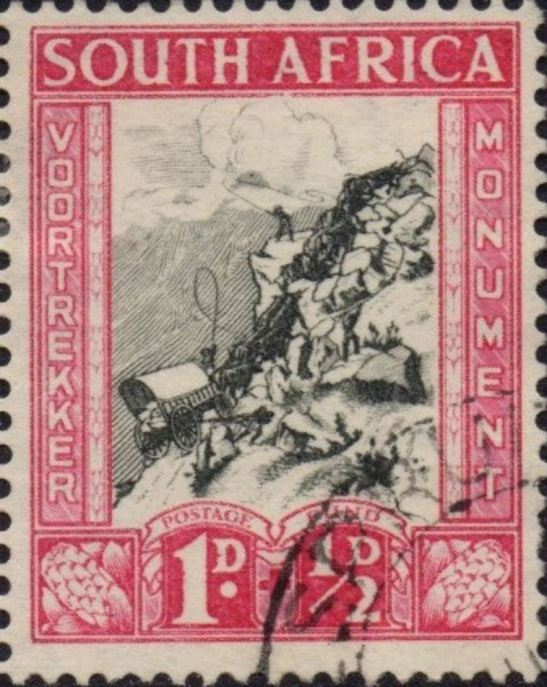
(below) The artist to this painting was clearly influenced by Michell’s earlier painting. It portrays dramatic Cape-Dutch farmers attempting to anchor their wagon while crossing a mountain range.
(above) A wagon and Cape-cart and wagon ascending Montagu Pass, Cape.
(above) A wagon descending Montagu Pass, Cape.
(above) A drawing of a wagon travelling along the road between Pietermaritzburg and Durban. In the background is ‘Table Mountain’ Natal.
(above) A painting by Dutch Artist and Traveller – Jan Brandes, of a Cape wagon descending a steep hill. In the foreground a span of oxen is portrayed ploughing a field.
(below) A lithographic print of a wagon descending the very dangerous Kaaimansgat Pass near Plettenberg Bay, Cape.
(above) A lithographic print of two wagons ascending the precipitous Paardekop Pass, Cape.
(above) A painting of a transport wagon on the Sabi Pass road. Transvaal.
(above) An engraving of a a train of wagons descending a mountain pass in South Africa, 1857.
(above) An engraving of an ox-wagon descending a mountain pass.
(above) An ox-wagon ascending a mountain road at the Cape.
(above) An engraving of a loaded wagon ascending a mountain.
(above) drawing of a wagon being attacked by Xhosas on a mountain road, Eastern Cape, 1830’s.
(above) A wagon being attacked on a mountainous road by Xhosas, Eastern Cape.
(above) An traveller in his wagon on a mountain road being mobbed for spirits, Cape.
(above) An ox-wagon ascending Stormberg Pass, Natal.
(above) A wagon pulled by horses on the Roodezandt Pass (Rooisand). Cape.
A wooden engraving after Burchell of two wagons ascending Roodezandt Pass, Cape. 1811.
(above) An engraving of a wagon on a mountain road at the Cape.
(above) A painting by Thomas Baines of a wagon train descending a pass near Sidbury, Cape.
(above) The road to Naamrap, Cape.
(above) A painting by the English Artist – Frank Dadd of a Boer farmer, Transvaal, late 1900’s
(above) A wagon ascending a mountain with the Kei River in the valley below, 1877, Eastern Cape.
(above) British troops shelling Boer forces at lang’s Nek, Majuba, Pass, 1st Anglo-Boer War, Northern Natal.
(above) An engraving of wagons outspanned near a rocky outcrop. Cape.
(above) A drawing by James Walton of wagons ascending Bosch Nek, Elandsberg. Cape.
(above) Photograph of wagons on the Van Staden’s Pass, Cape.
(above) A wagon ascending a mountain road.
(above) A woodcut print of a wagon cresting a mountain top.
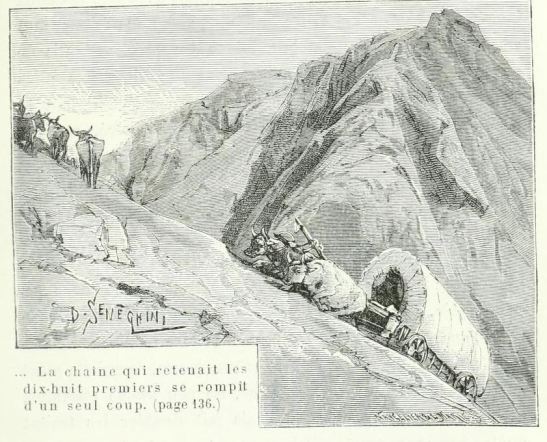
(above) A catastrophic separation of the trektouw from the disselboom hook.
————————————————————-
THEME 3. TREKKING ACROSS THE VELDT
(above) A wagon trekking past Rondebosch with Table Mountain and Devil’s Peak in the background.
(above) A drawing by Heinrich Egersdorfer of a transport wagon trekking.
(above) A wagon trekking over the veldt.
(above) A painting of a wagon trekking in the Cape.
(above) The trek gets underway after inspanning the oxen.
(above) A painting by Charles Bell of a wine wagon trekking across the Cape Flats.
(above) A wagon trekking up the hill towards Fort Amiel after crossing the Incandu Drift below, Newcastle, Northern Natal.
(above) A wagon convoy crossing the veldt.
(above) A painting by the Artist and Surveyor Charles Bell of a Cape-wagon with two Cape-Malay drivers.
(above) A large span of oxen drawing a wagon loaded with hay.
(above) A painting by the Artist – I. R. Skelton of the 1838 Voortrekkers heading-off into the interior.
(above) A photograph of a train of wagons trekking across the Kalahari.
(above) A drawing of a wagon being pulled by a span of donkeys and oxen.
(above) An engraving of a wagon trekking in the Cradock district, Cape.
(above) A photograph by the Missionary, Author and Photographer Alfred Bertrand of his wagon and Cape-cart trekking.
(above) An engraving showing Swedish Explorer Anderson setting out on a trek during a rainstorm.
(above) A photograph of an ox-wagon in Mozambique.
(above) A painting of a transport wagon trekking in the Hex River Valley, Cape.
(above) A transport wagon approaching a South African farmstead.
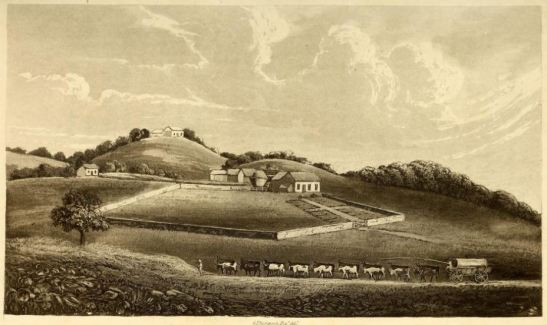
(above) A wagon and span of oxen approaching Thornhill near Fort Francis.
(above) A wood engraving of a wagon trekking through long grass, by Branston after a drawing by Burchell, 1812.
(above) A painting by Burchell of the Klaarwater settlement at the Cape, with a wagon trekking-off in the distance. 1811.
(above) A painting by Burchell of a wagon trekking away from a Cape farmstead, 1811.
(above) An engraving by Burchell of his wagon trekking in the Cape, 1811.
(above) A postcard captioned ‘A typical ox-wagon – South Africa”.
(above) A family trekking in their transport-wagon.
(above) A drawing of an ox-drawn Cape-wagon setting-off on a trek.
(above) A wagon trekking with Pretoria in the distance.
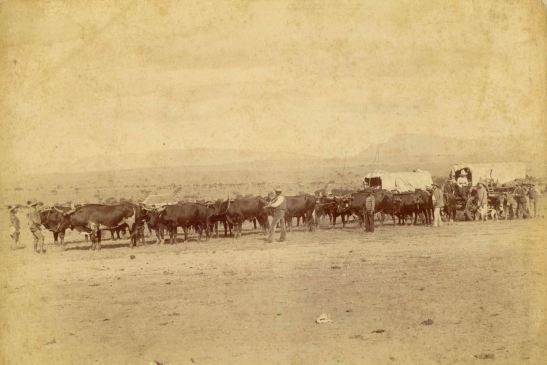
………………………………………………………………………………………………………………
THE WAGON AT WORK
(above) The Cape wagon and transport wagon had always filled-in as a caravan and people-carrier. In this image a Boer family sets out on a journey from their farmstead.
(above) A wagon transporting mowed hay on a farm.
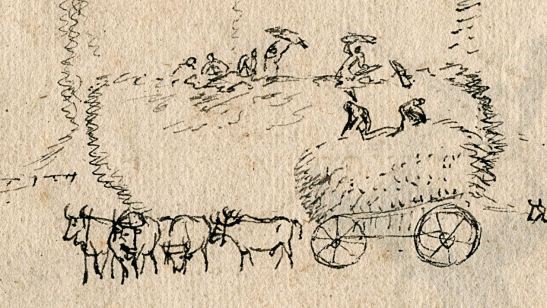
(above) A sketch by an unknown visitor to the Cape from c1700 of a Cape Wagon being loaded with hay or wheat at harvest time.

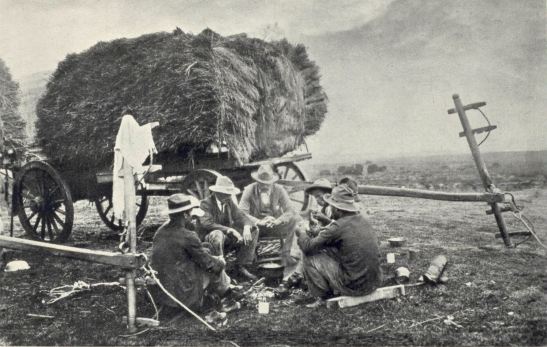
(above) A Cape-wagon and a Transport wagon photographed transporting bales of wool in Northern Natal, 1870’s.
(above) A visually interesting photograph of the arrival of Boer transport vehicles at Elandslaagte. Many of these carts, wagons and carriages had been purloined from the ‘Buiterlanders’ (British immigrants) and from Natalian Settlers as the Boer forces descended from Volksrust, down the escarpment and through the town of Newcastle towards Elandslaagte and their first confrontation with British and Colonial soldiers. This triumphant vanguard, led by General Ben Viljoen and made up Boers and an adventurous contingent of Dutch freebooters called the ‘Hollanderskorps’ were responsible for the looting of Newcastle and district. They were mauled at Elandslaagte, and most of the Hollanderskorp under Dr. H. J Coster were killed. 1899.
(above) A painting of British Army transport-wagons crossing the Tugela River into Zululand.
(above) A transport wagon heavily-laden with boxed freight.
(above) A transport wagon pauses alongside a railway station. The advent of the railway reduced the need for the transport wagon. However – wagons were still necessary to move goods from and to the stations, and along routes not yet reached by rail.
(above) A fascinating image from 1918 of a transport wagon and an automobile. The modern world had at last caught up with the ox-drawn wagon. Within a few decades the wagon would disappear from the South African landscape for good.
————————————————————————–
THEME 4. THE WAGON LAAGER
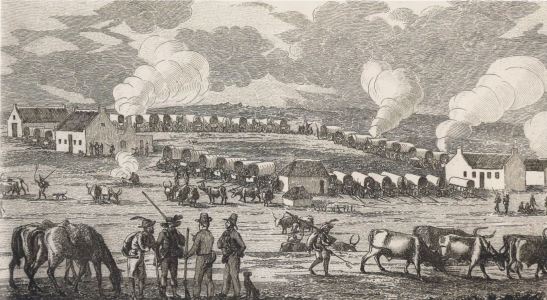
(above) An engraving by Charles Michell of Field Cornet Buchner’s laager on the farm, Quagga’s Vlackte, 1835. It was during the Frontier Wars on the Eastern Cape that the strategy of drawing wagons into a ring as a form of defence was developed.
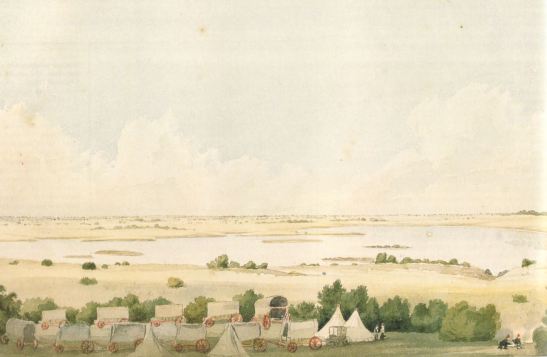
(above) A painting by Charles Bell of a wagon laager at Kuruman on the banks of the Great Choai’ Saltpan.
(above) A painting by Margaret J. Carey of the Voortrekkers taking a vow at ‘Danskraal’, Natal, 9 Dec 1838.

(above) A pen and wash drawing by Charles Bell of Jan Nel’s Laager, War of the Axe, 1846.
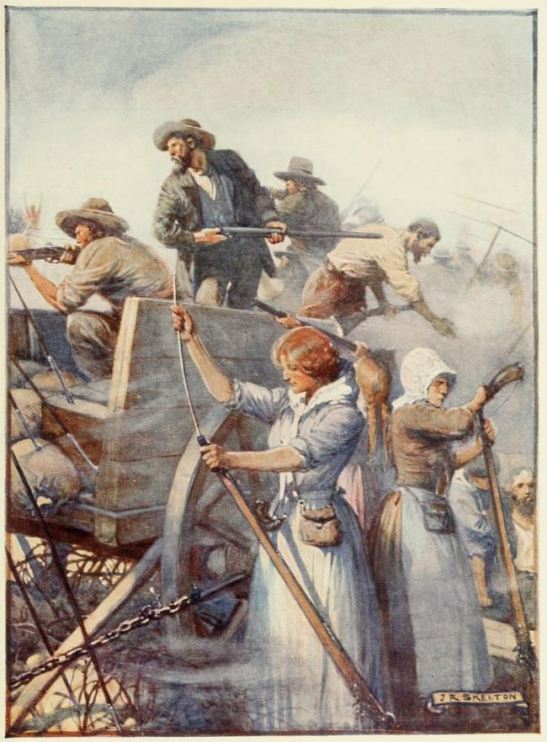
(above) An heroic painting by J. R. Skelton of women assisting their men in defending a laager by re-loading their muskets.
(above) This painting depicts a ‘veglaager’ (fighting laager) during the Cape Dutch farmer exodus from the Cape to Natal and Transorangia.

(above) A somewhat naive painting by Robert Jacob Gordon, of a laager/encampment on the Zeekoei River (present Colesberg district) 1778.

(above) A small laager of 4 wagons. In this engraving the oxen have been left outside the protective circle of the wagons. The artist has depicted the ominous presence of two stalking lions in the undergrowth.
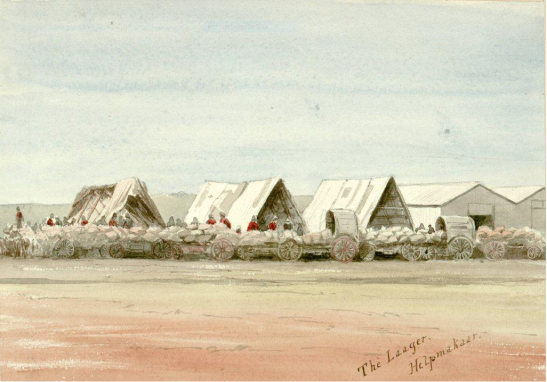
(above) A watercolour painting by the artist William Whitelock Lloyd, of a British laager at Helpmekaar, during the Anglo-Zulu War, Natal, 1879.
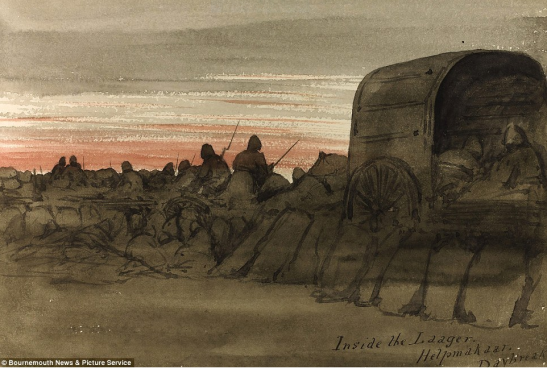
(above) Painting by William Whitelock Lloyd of the inside the laager at daybreak, Helpmekaar, Natal, 1879.
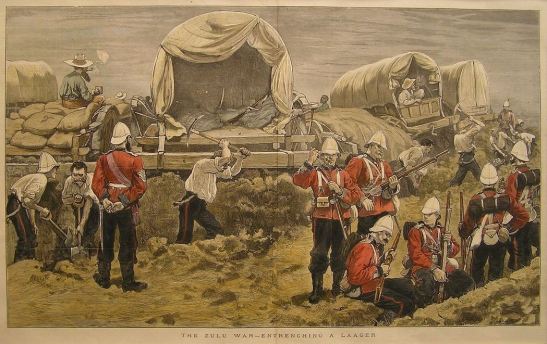
(above) A print of British soldiers throwing up defences around their wagon laager, Anglo-Zulu War, 1879
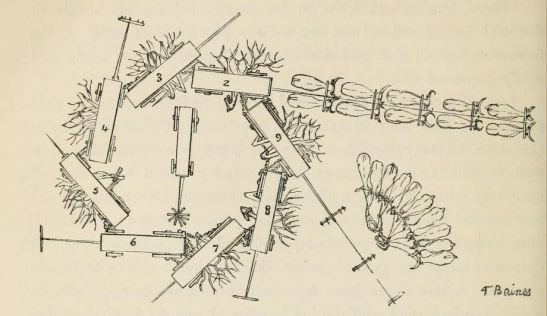
(above) Thomas Baines’ illustration of a method of laagering wagons.

(above) An illustration of the Battle of Blood River where the Cape-Dutch immigrants to Natal defended themselves from within a wagon against the the Zulu Impi of King Dingaan.
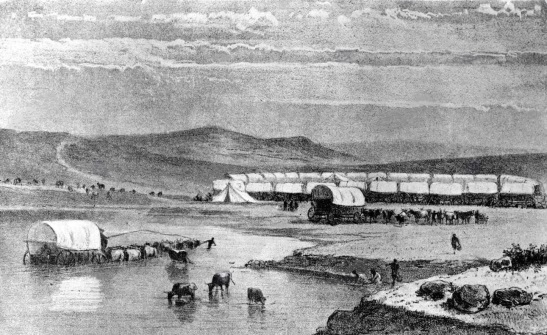
(above) A drawing of a laager on the Eastern Front of the Cape, 1835.

(above) A drawing by Capt. Smith of his wagon laager and entrenched encampment at Port Natal. Smith used this method to defend British and English Settlers from the assault of the Cape-Dutch farmers, 1842.
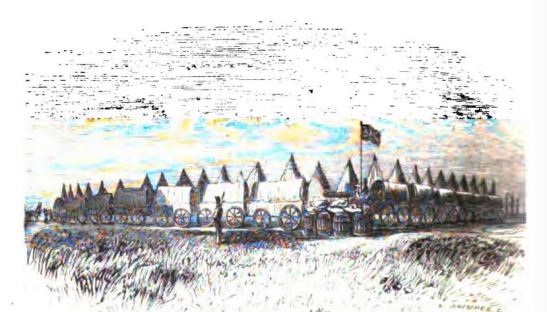
(above) The British wagon laager at Congella, 1842.
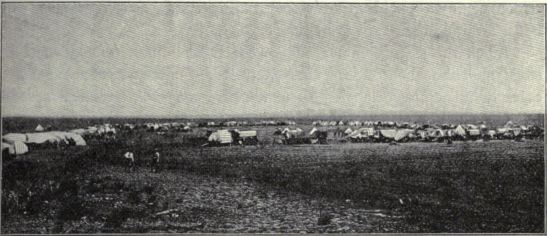
(above) The Boer laager outside the town of Kimberley during the siege. Anglo-Boer War, 1899.
—————————————————————–
THE HUNT
(above) Hunters pose alongside their wide-bodied hunting wagon and a dead antelope.
(above) The sheer destruction of game across the South African veldt is disturbing to a modern viewer. In this photograph, hunters pose alongside the day’s shoot, several dozen springbok. There is no doubt that such a taking was far in excess of the necessities of the pot. It was images such as these that drew hundreds of hunters to the country. By the mid 1800’s – the vast herds of migratory springbok were no more.
(above) A trophy hunter’s haul of gemsbok and kudu horns, as well as the skins of several felines.
(above) A hunter’s camp.
THE WAGON ABOUT TOWN
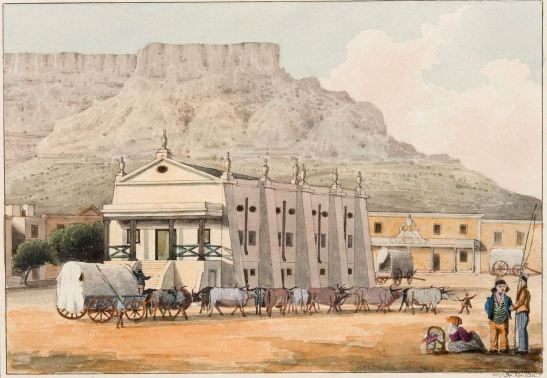
(above) A painting by H.C. de Maillon of a Cape wagon with the Theatre and Table Mountain in the background.
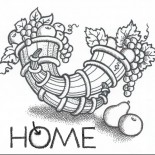

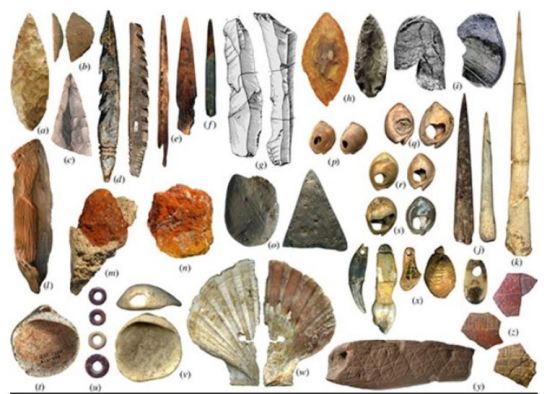
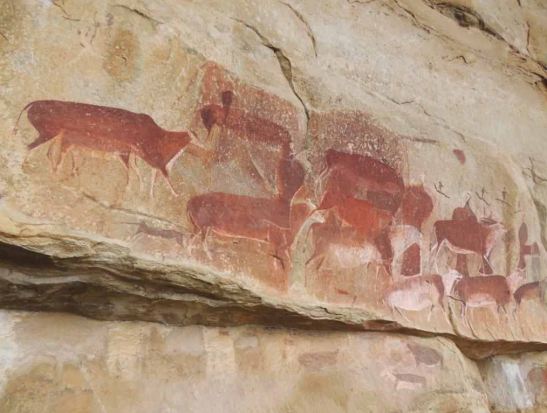
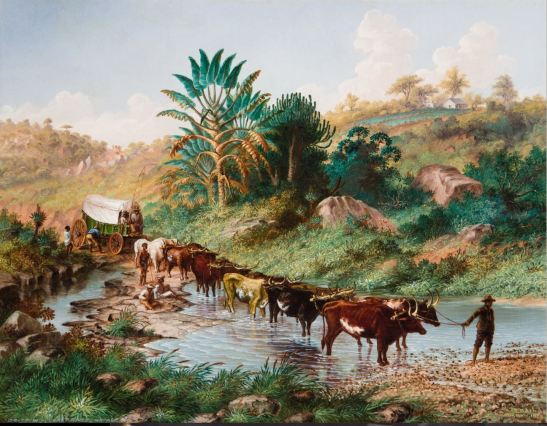
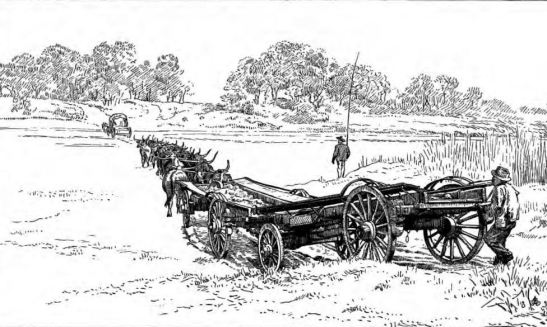


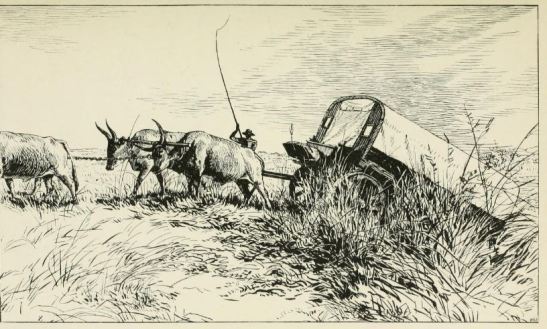
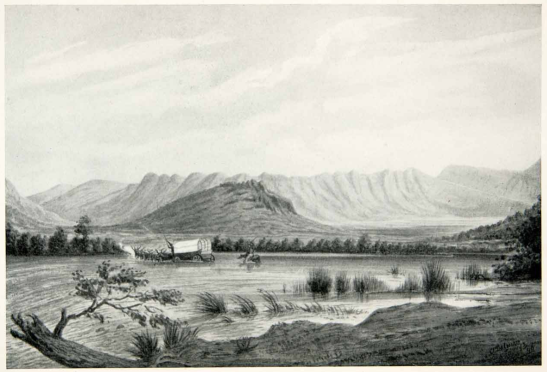
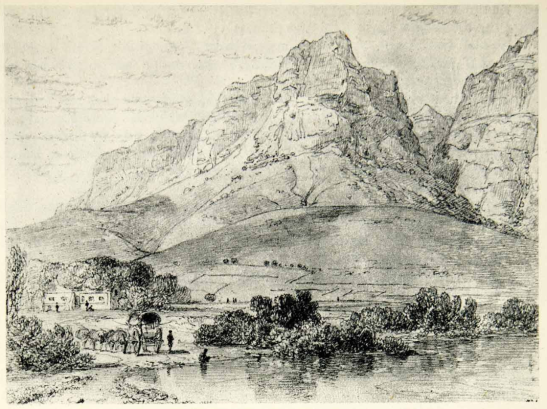
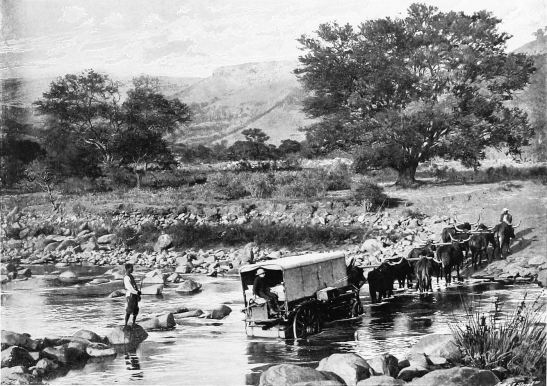
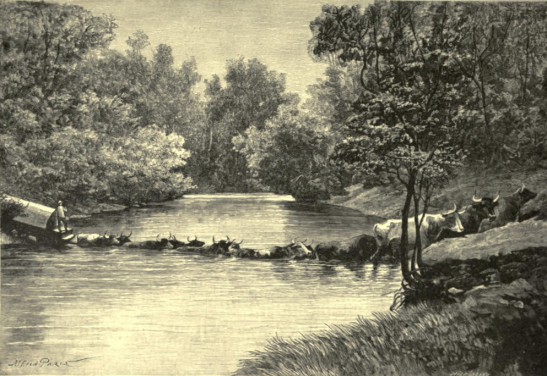
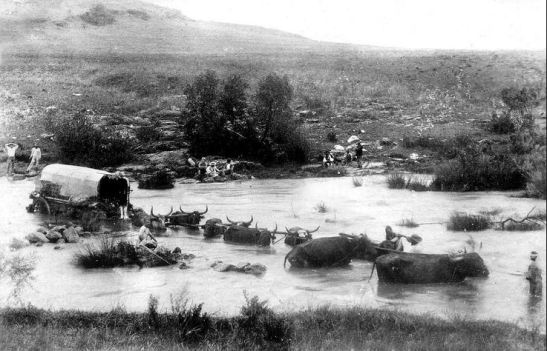
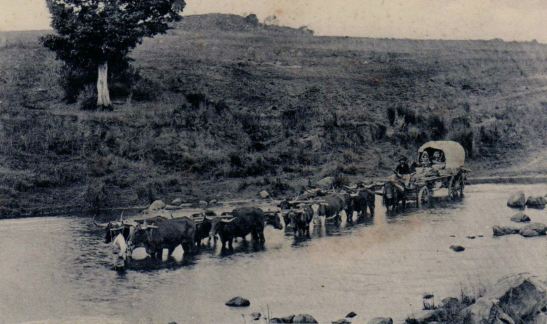
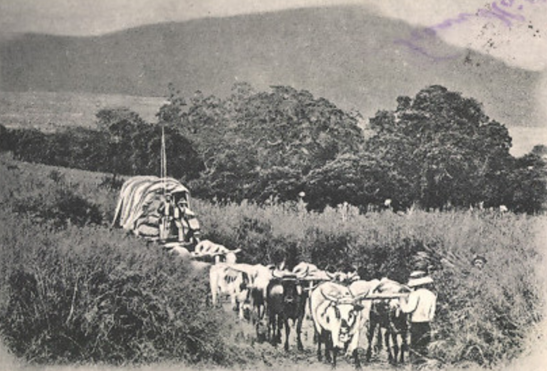
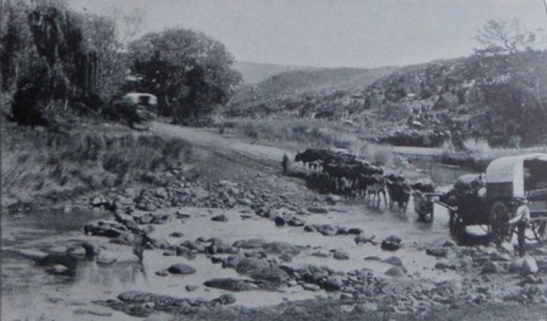
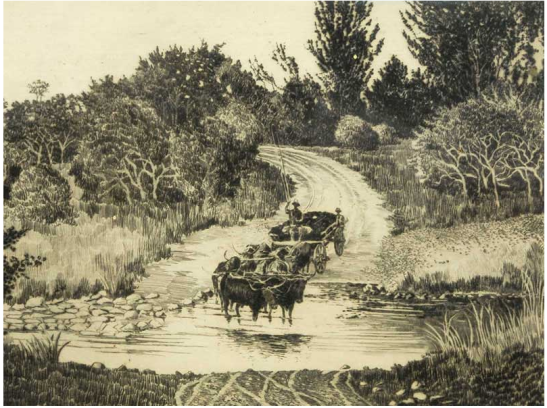
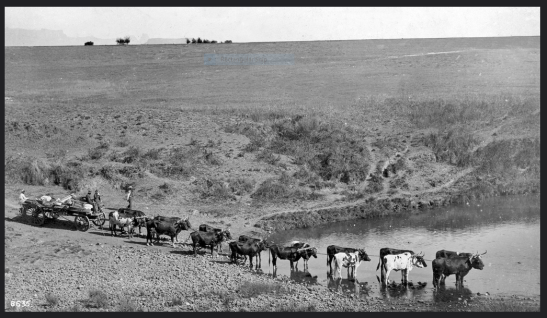
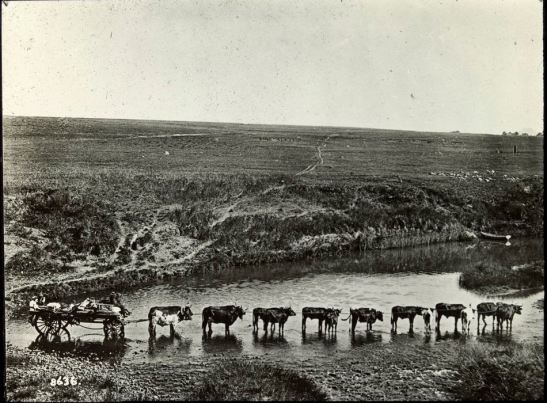
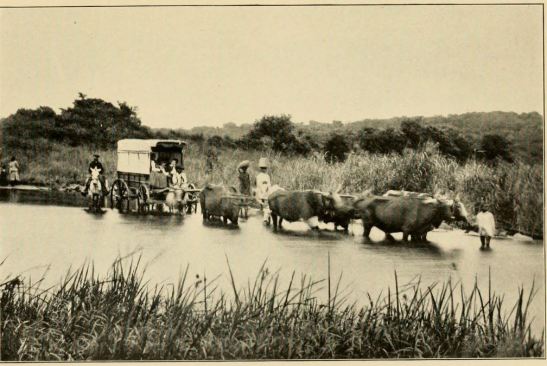
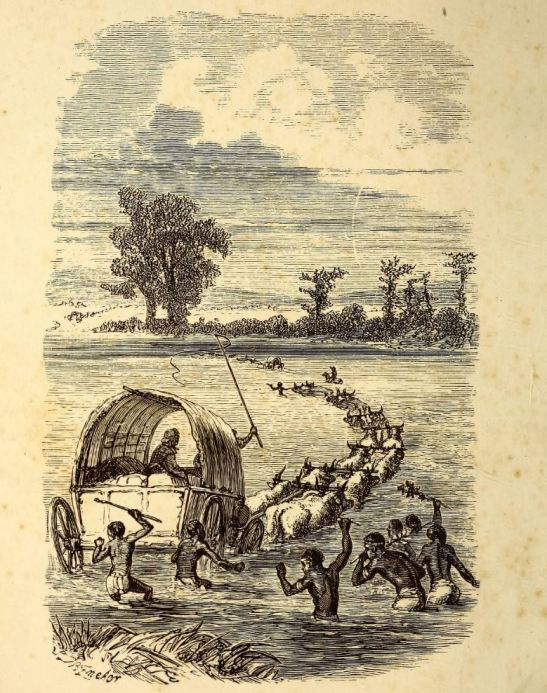
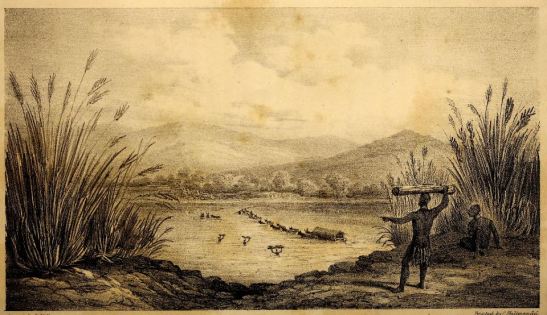

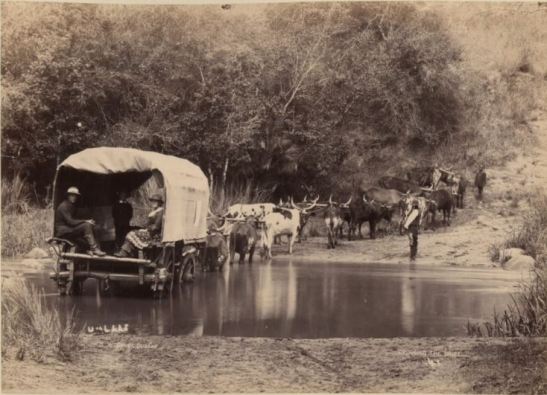
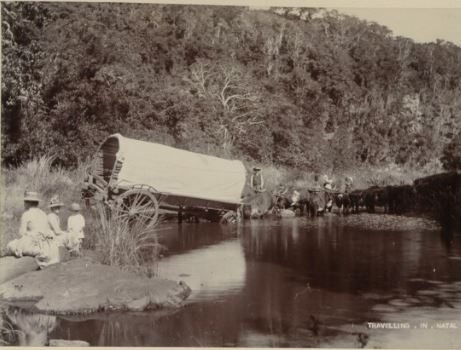




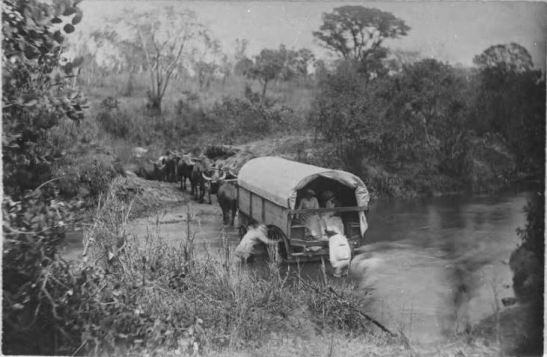

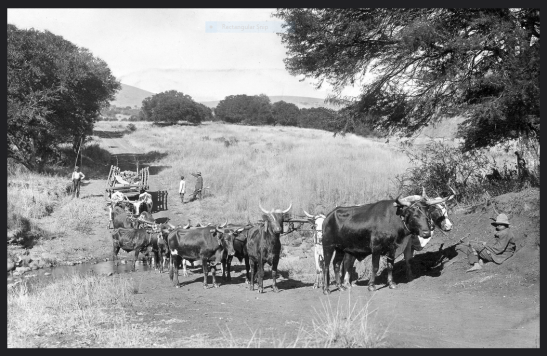
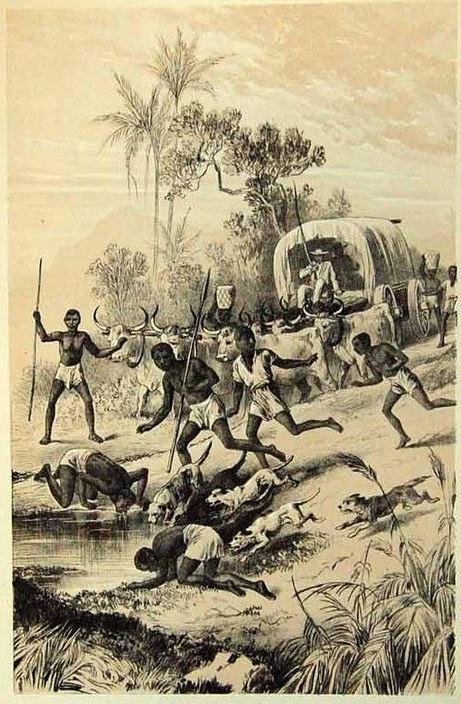
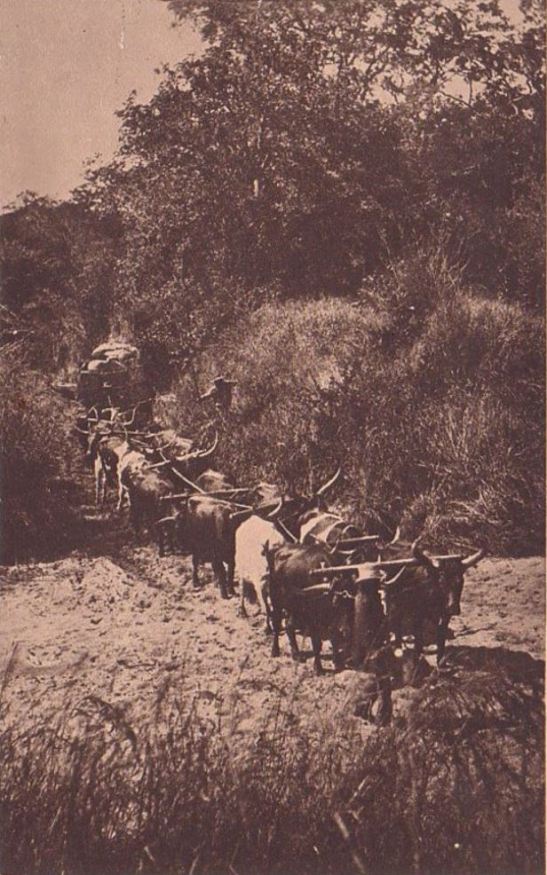
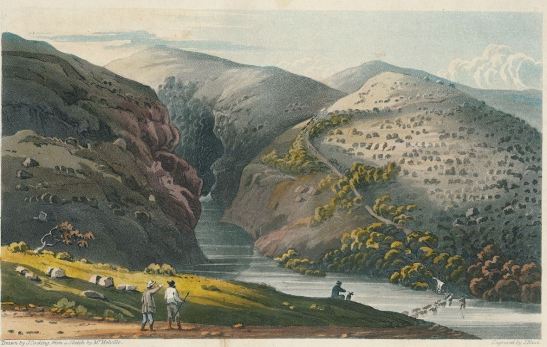


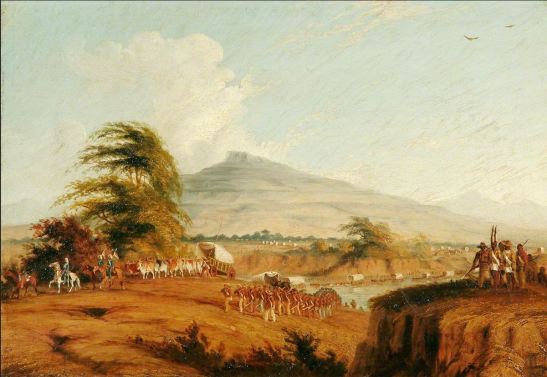

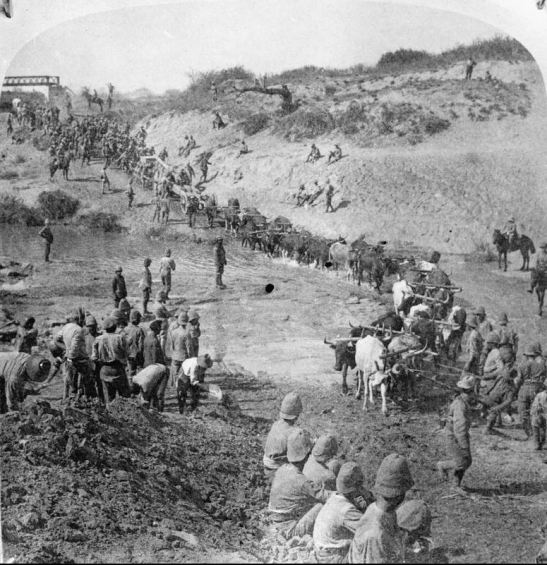
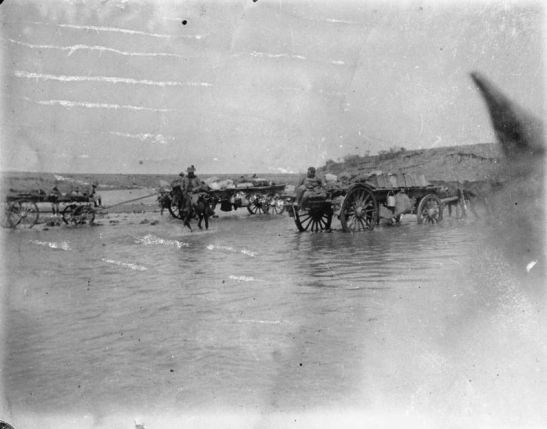
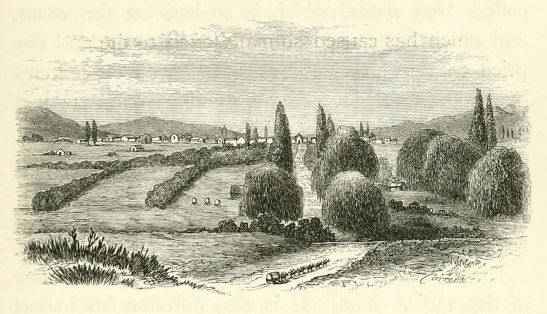
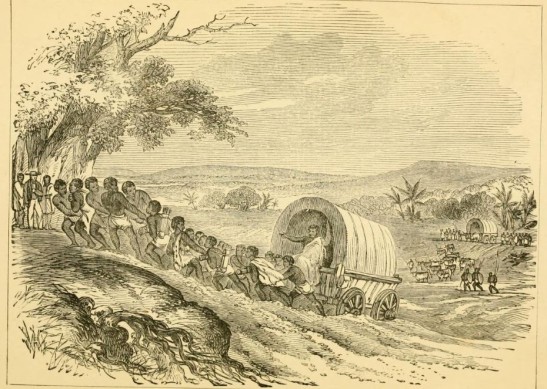
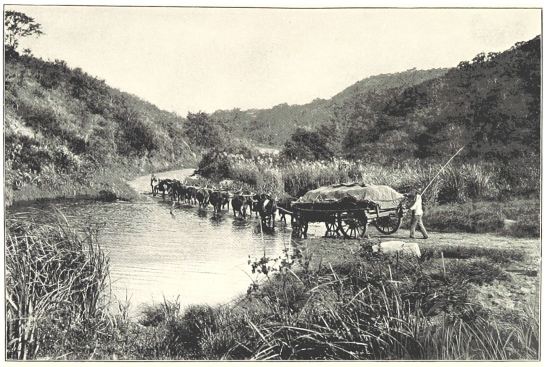
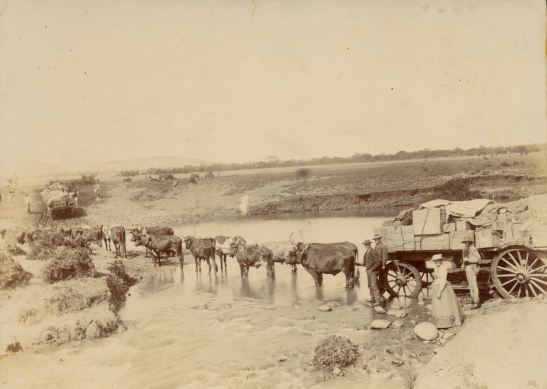
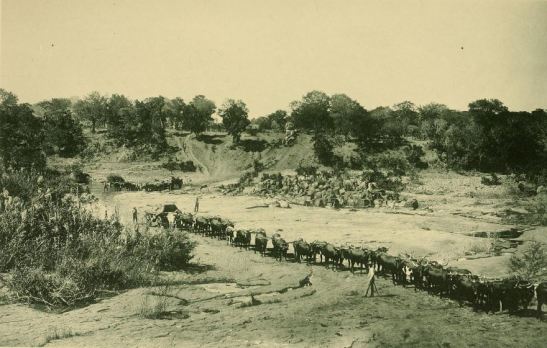
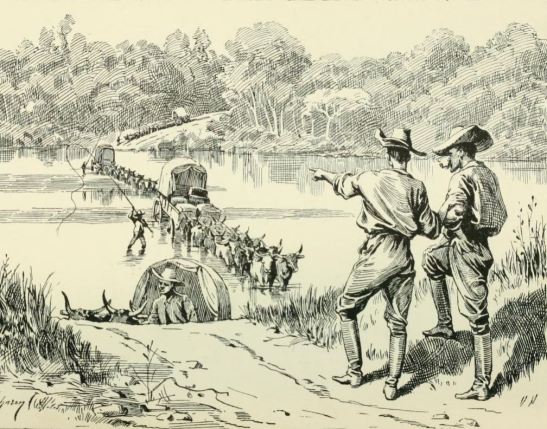
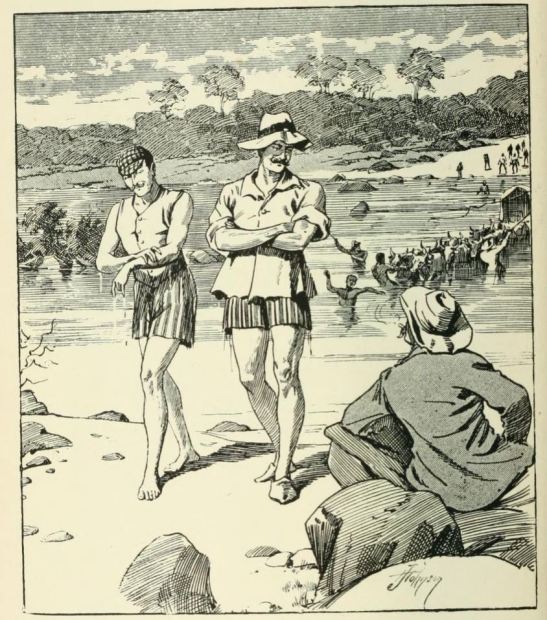
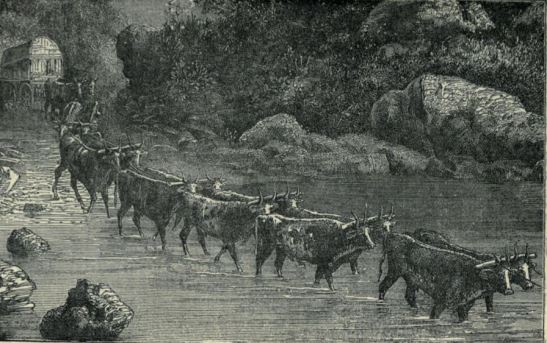
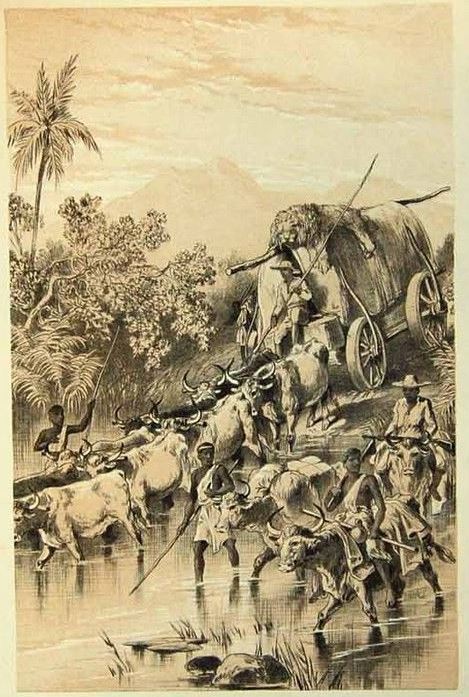



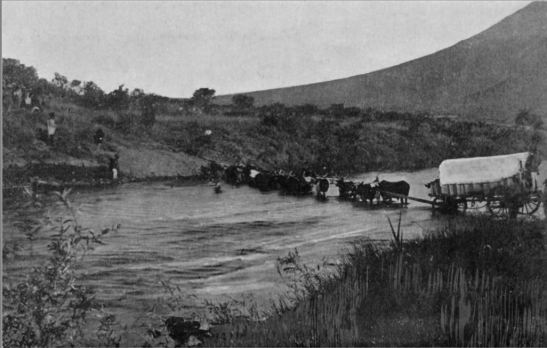
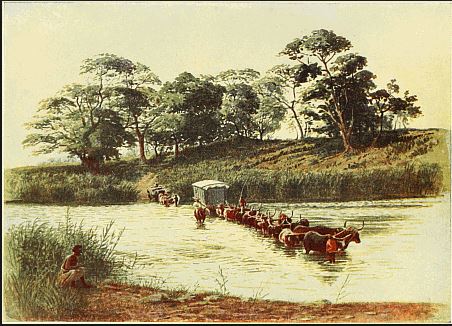
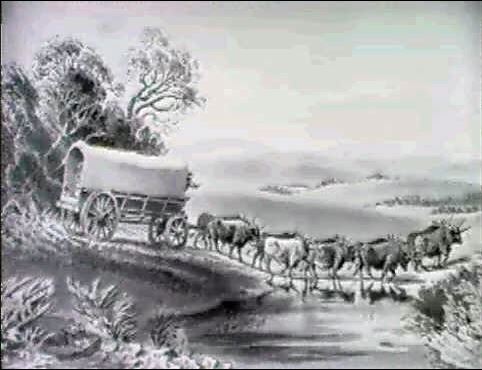
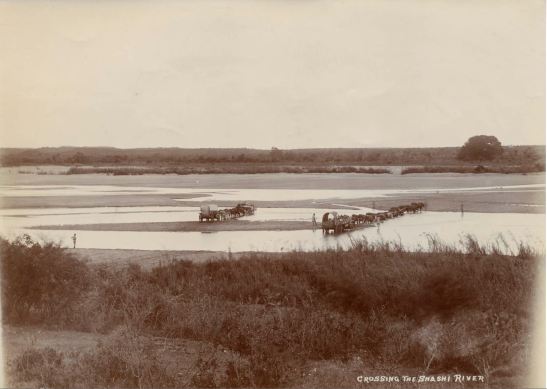
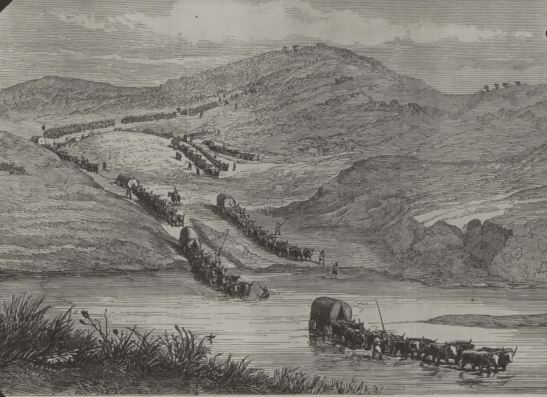

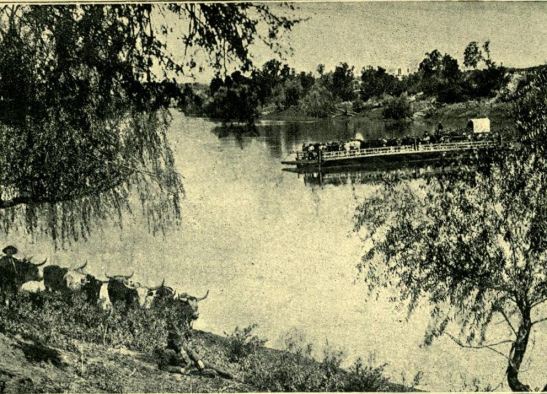

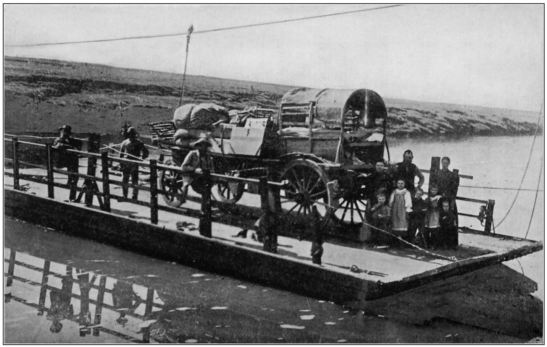
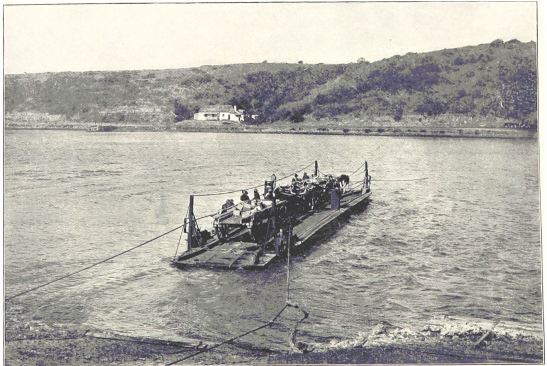
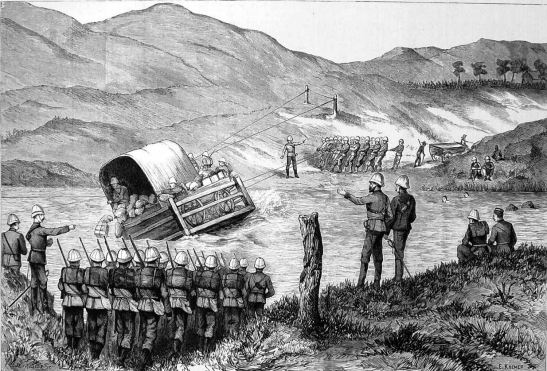
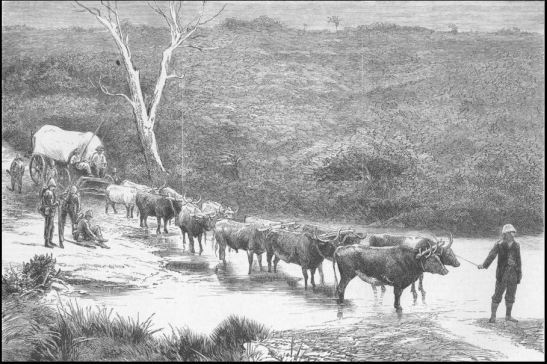
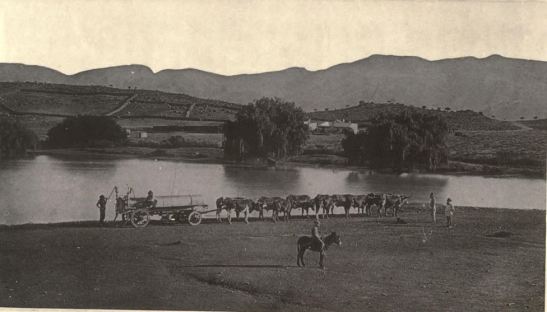
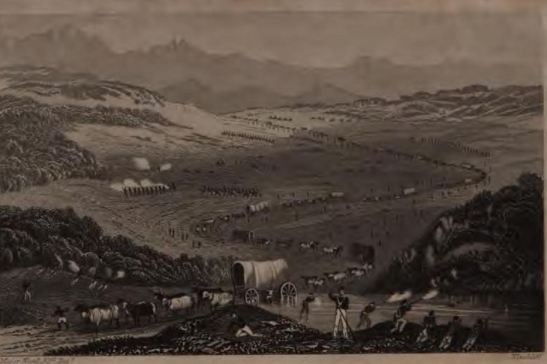

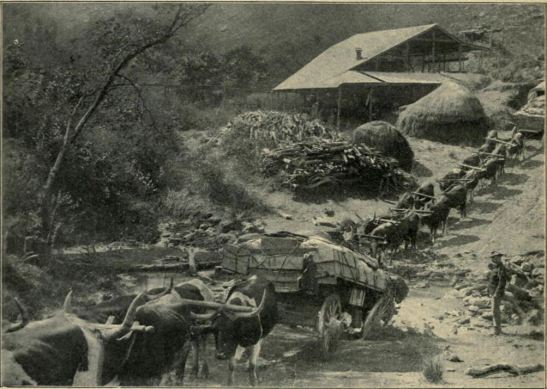
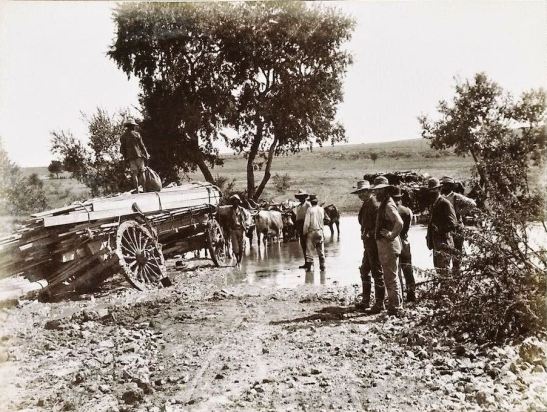
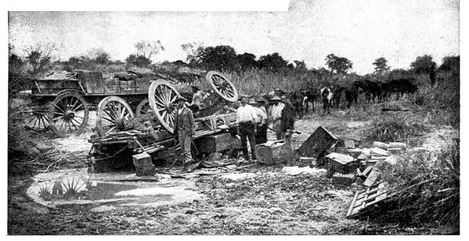
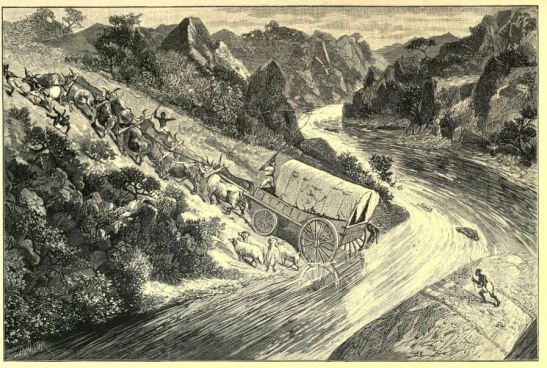
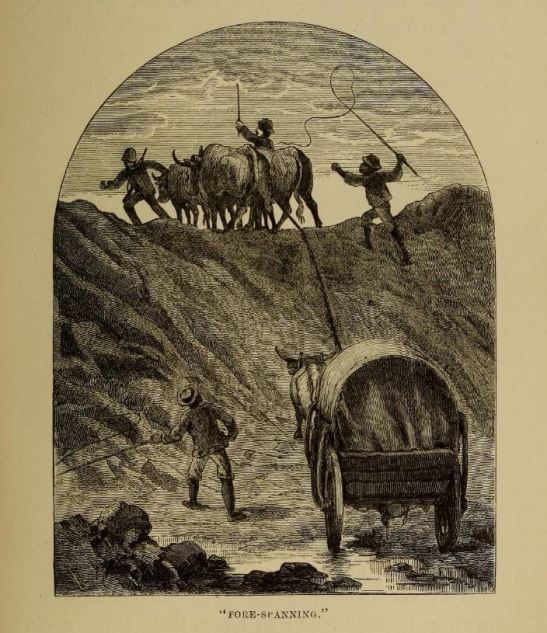
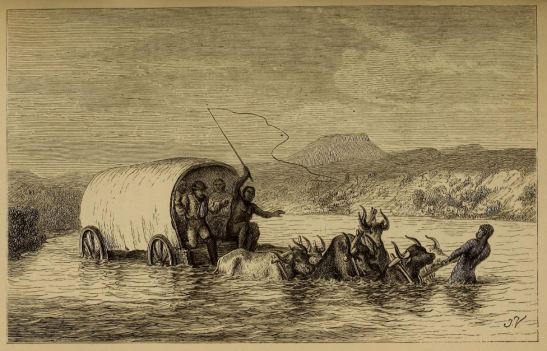

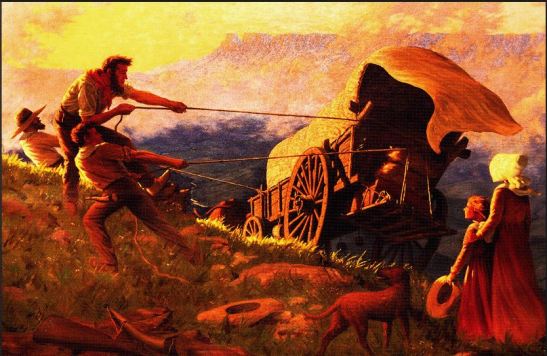

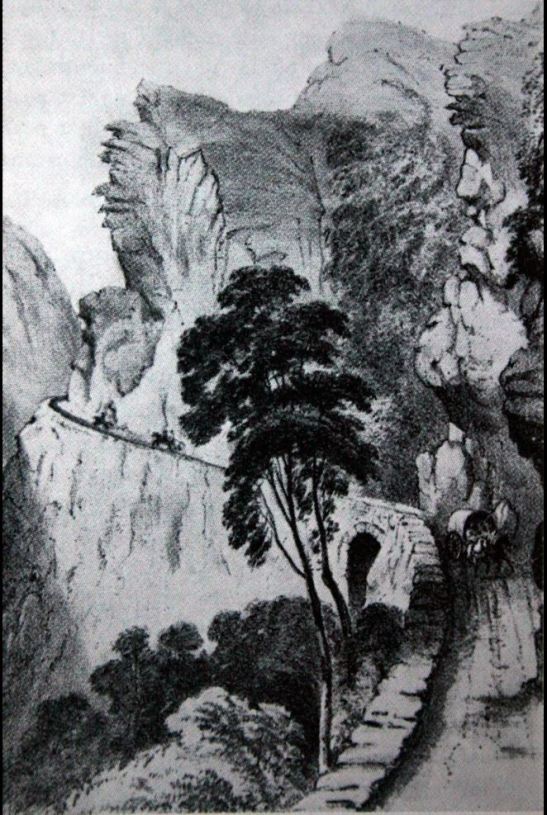
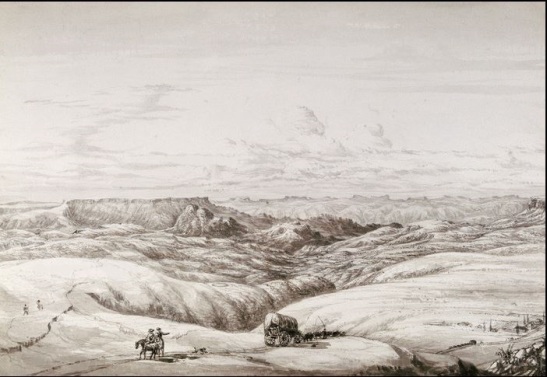
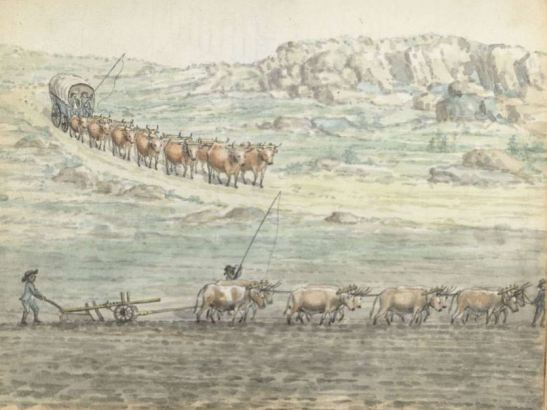

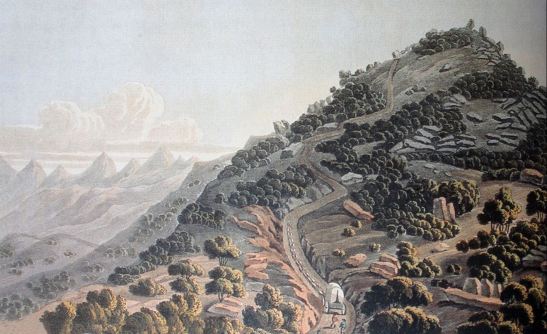
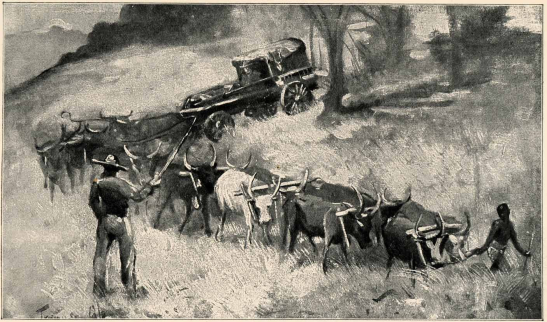

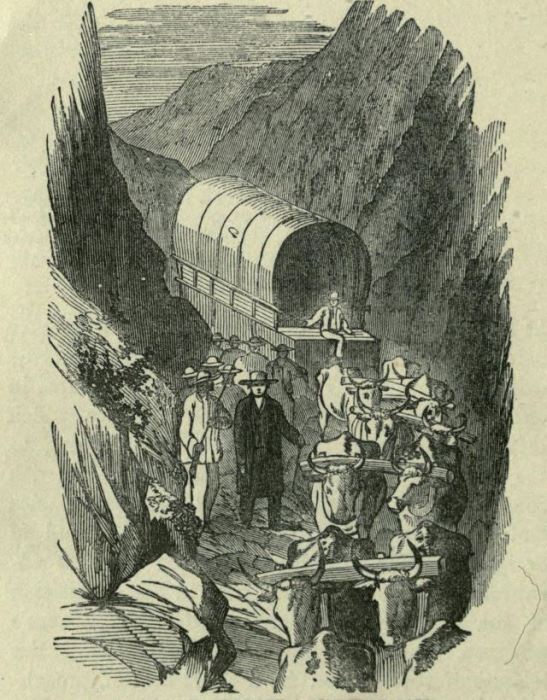
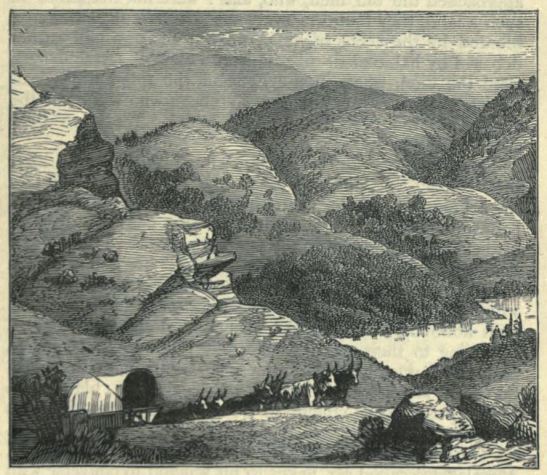

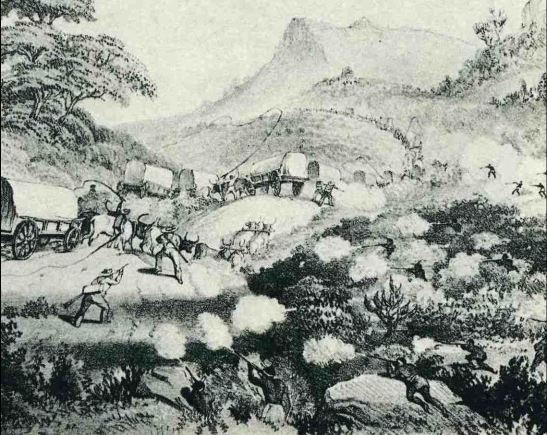
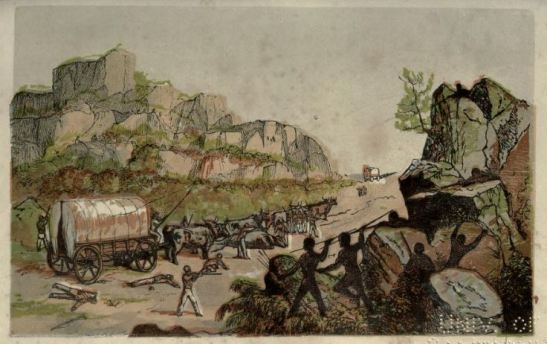
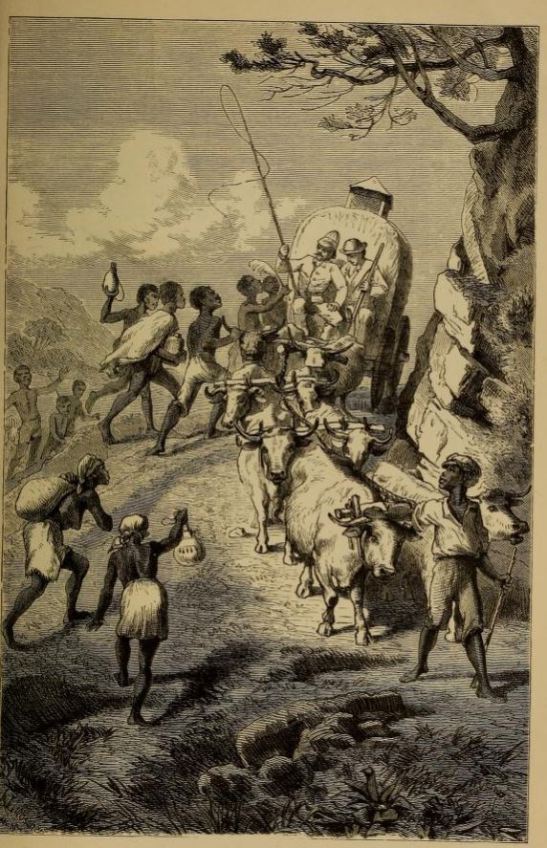
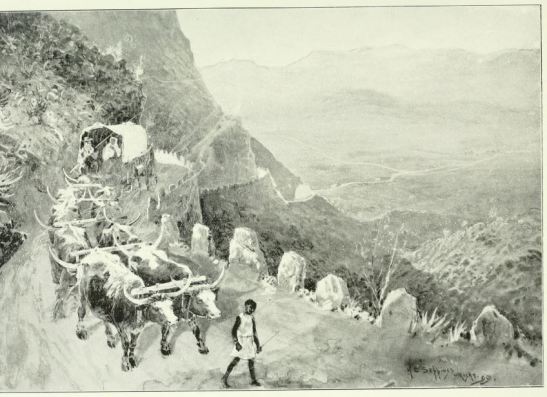
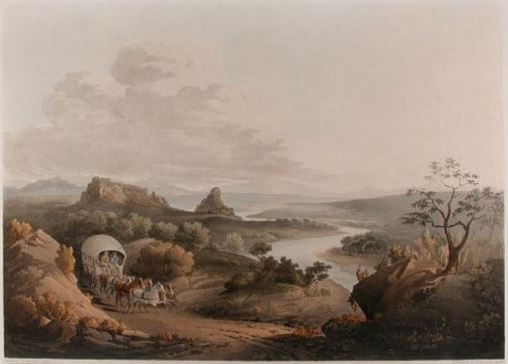

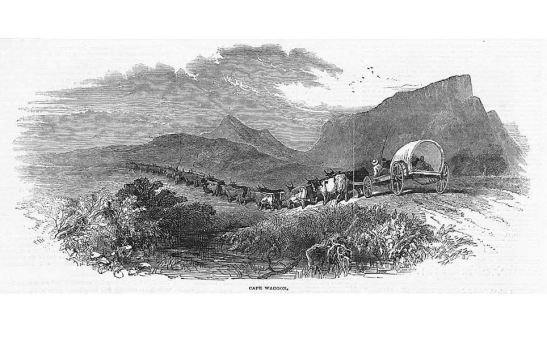
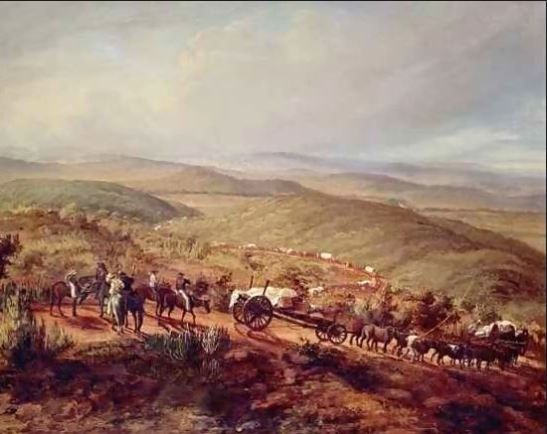

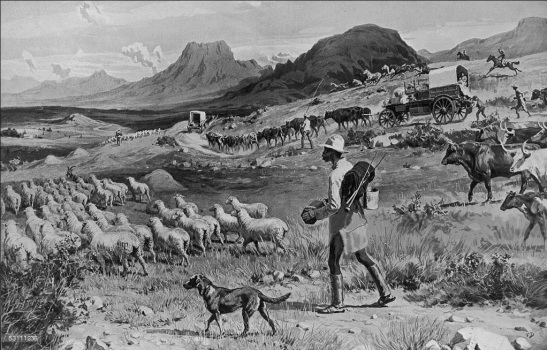

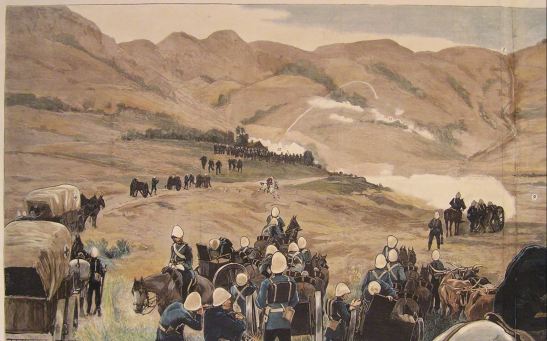

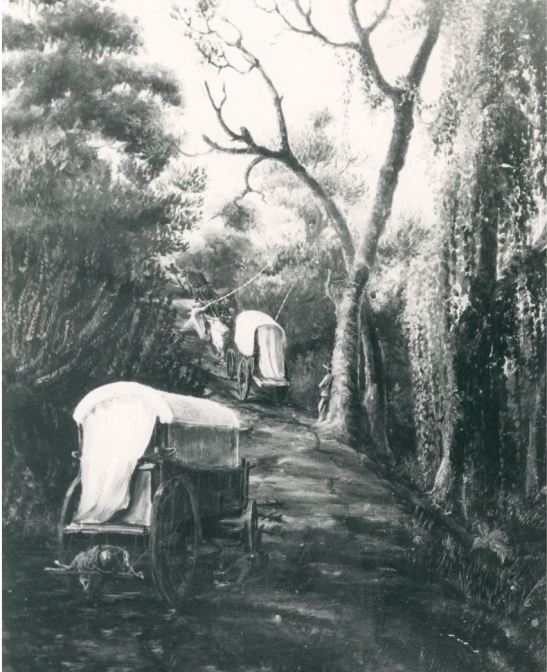
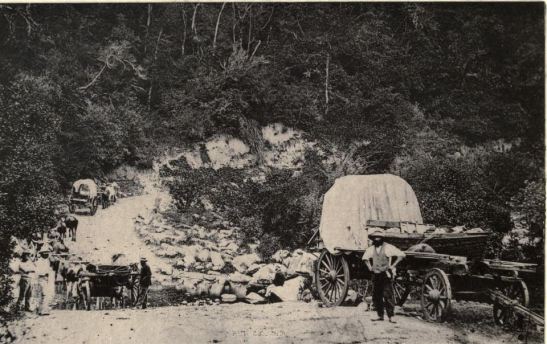
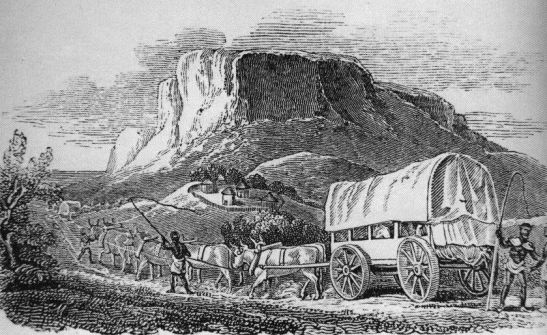


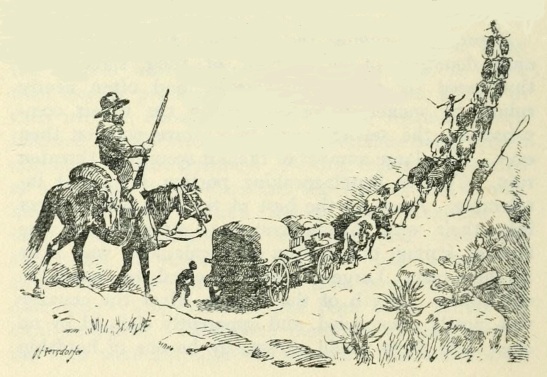
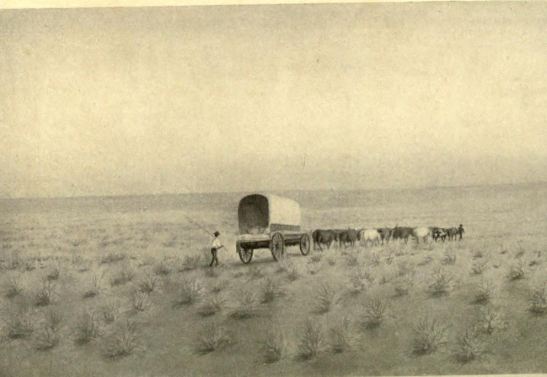

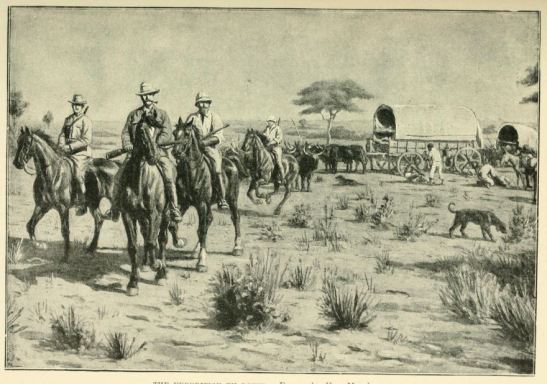

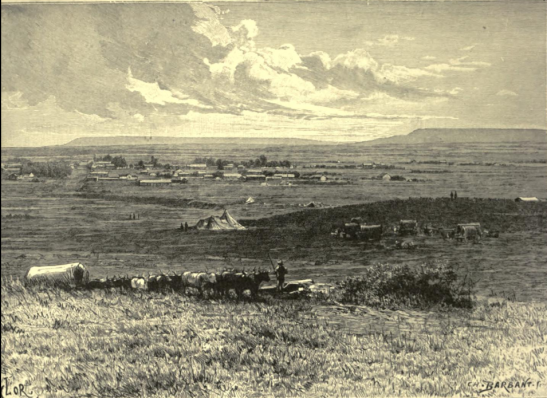

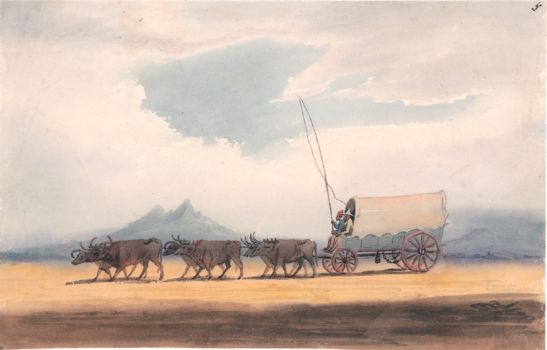
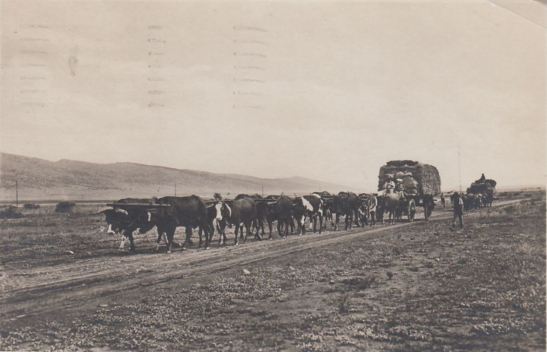
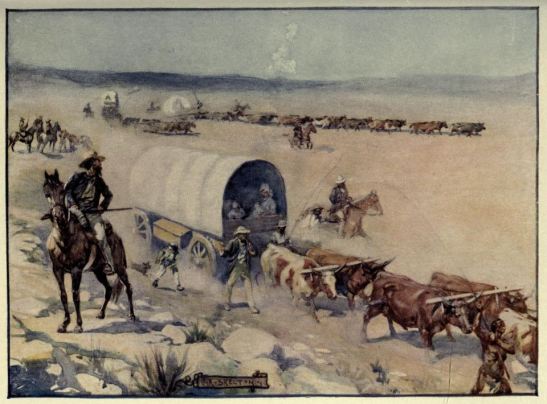
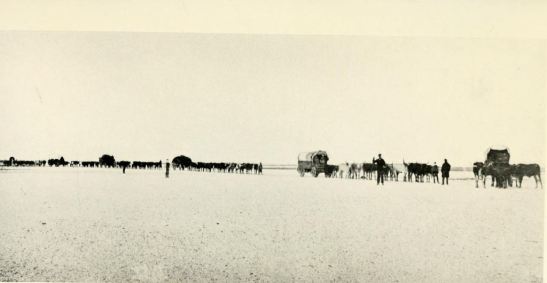

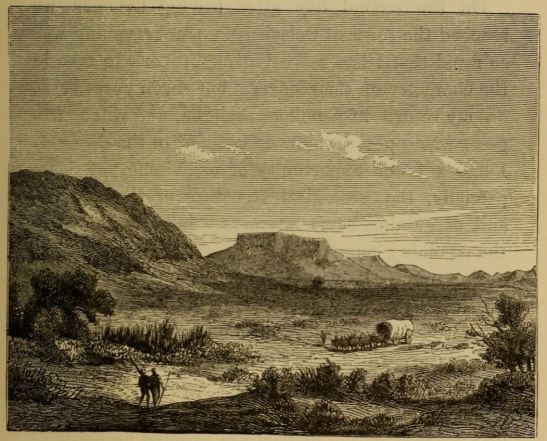
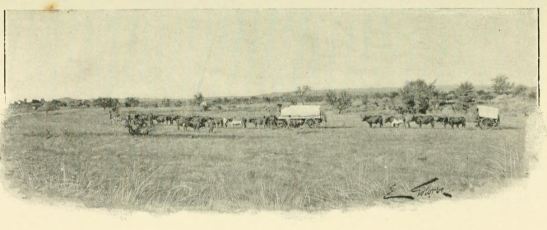
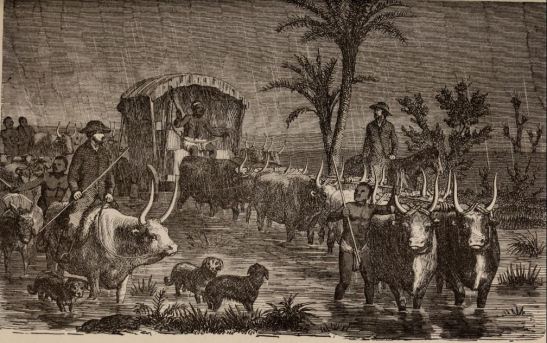
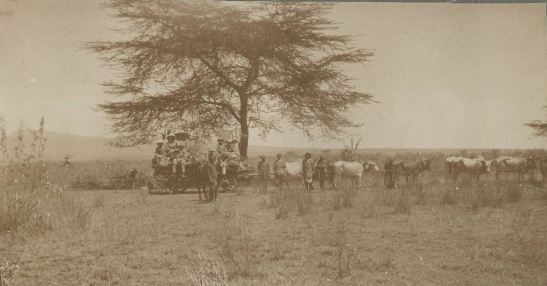

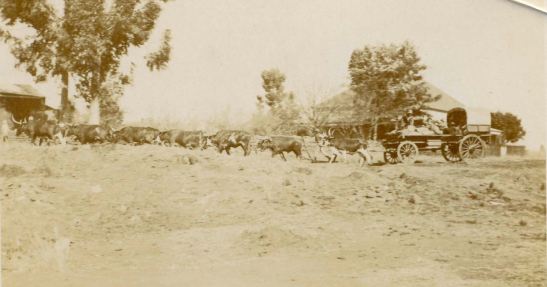
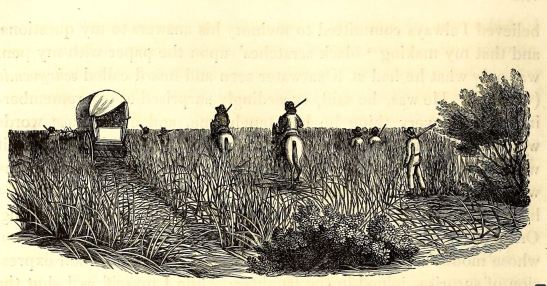
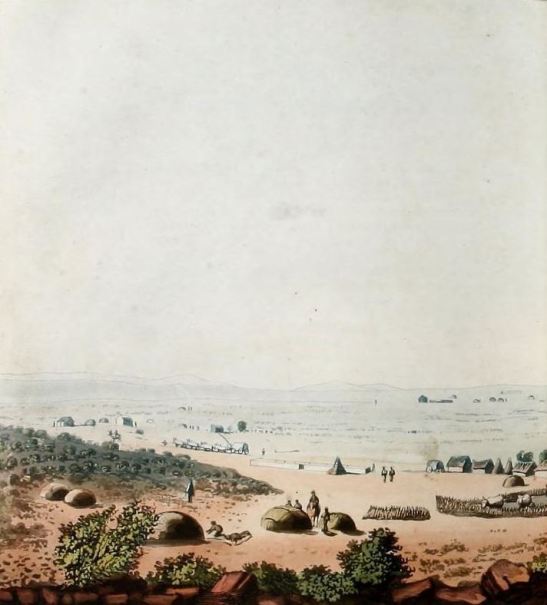
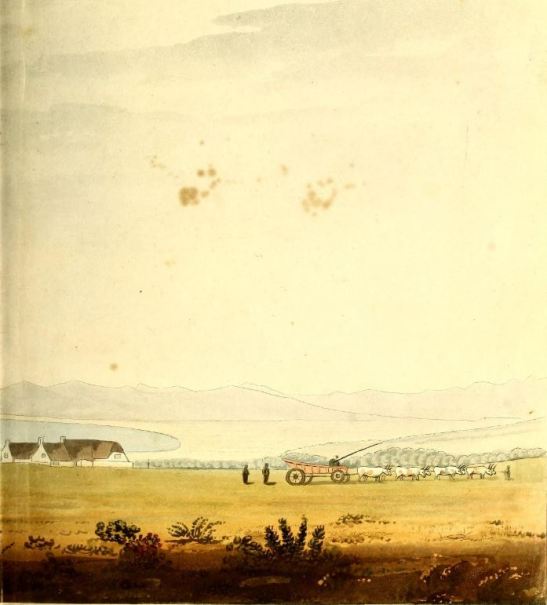
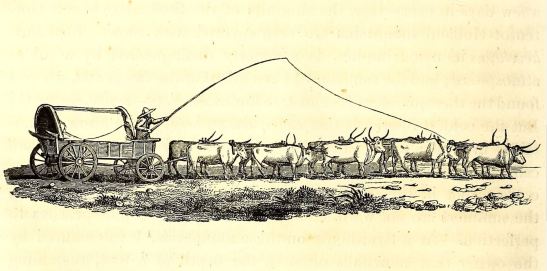
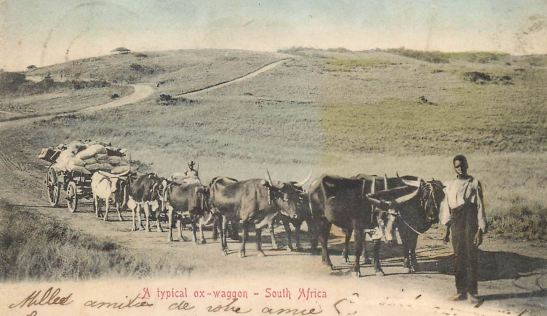
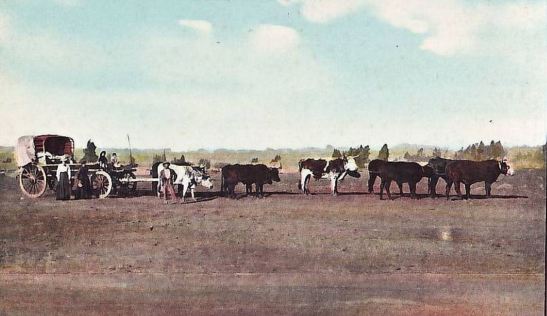
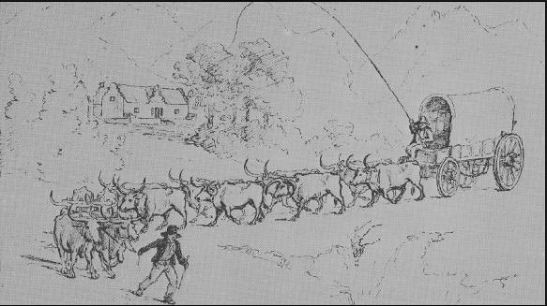
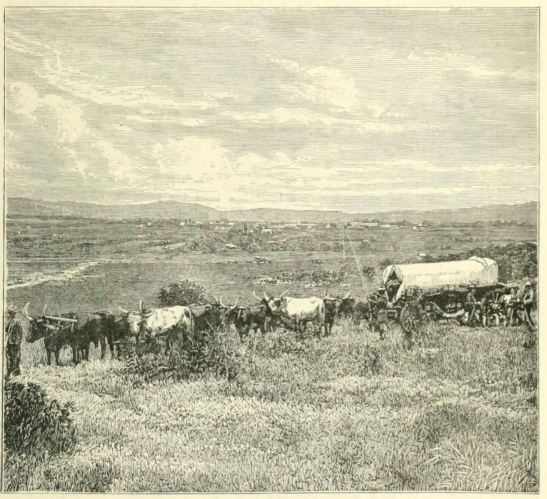


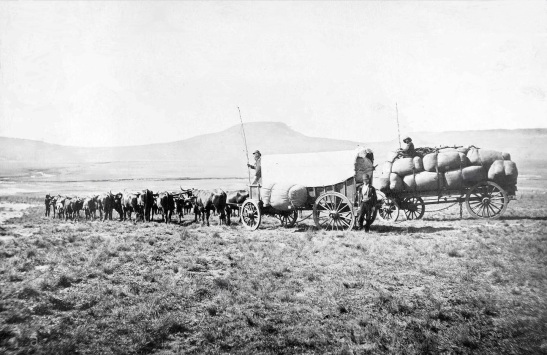
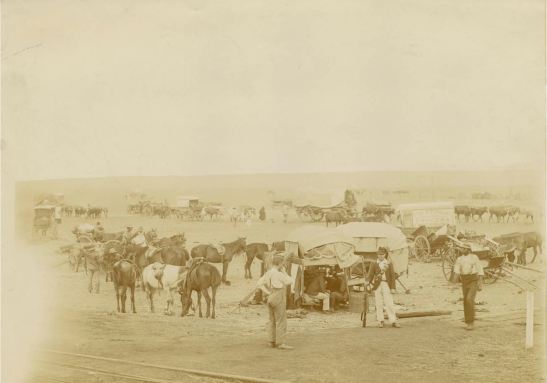
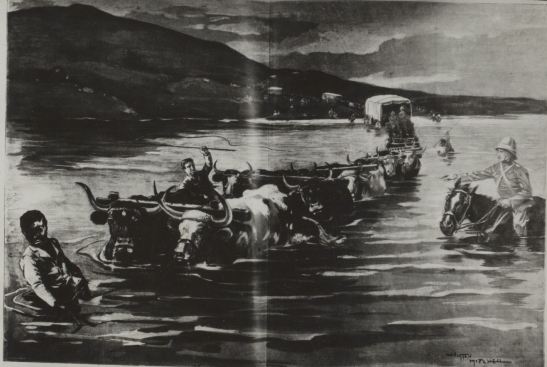
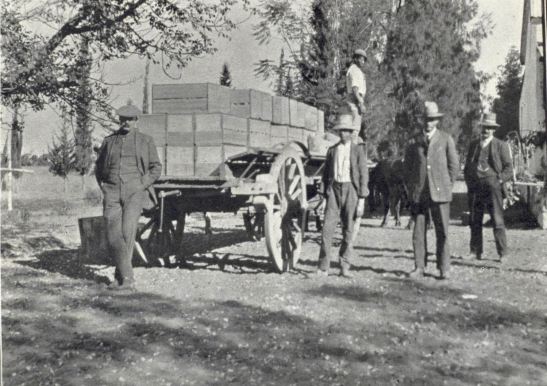
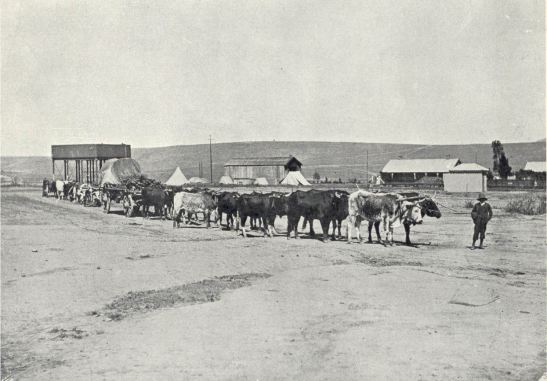
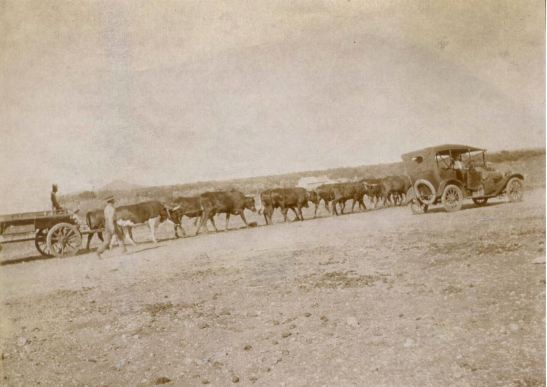
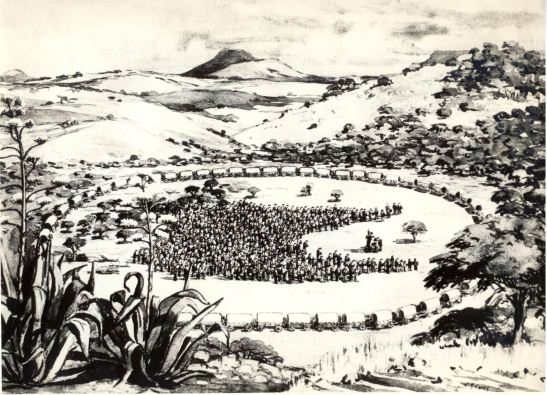
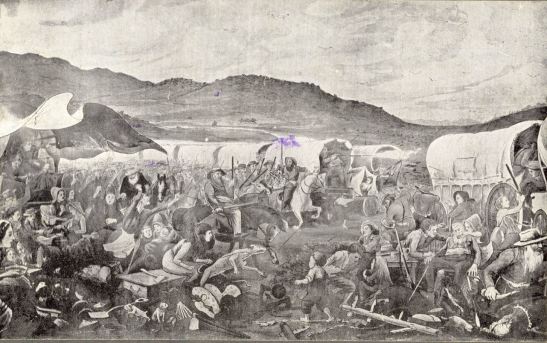
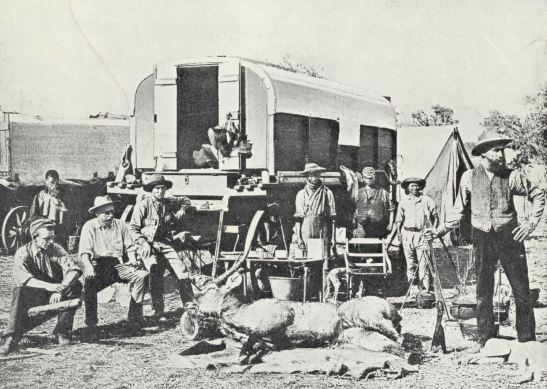

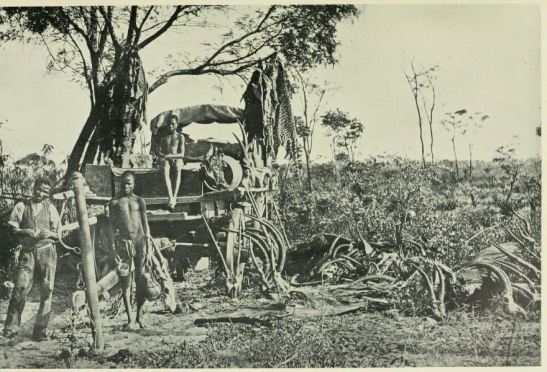
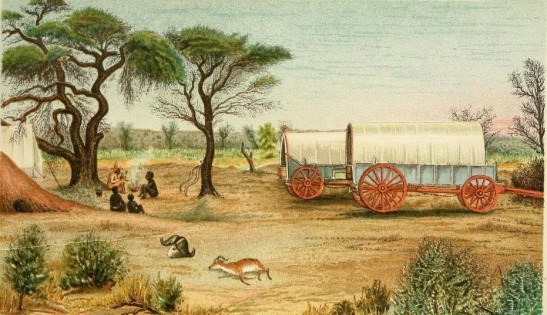
All your inputs are so well researched and the collectons of historic pics must be the best in SA.
Shown in the photographs above is one entitled: A photograph of a buck-wagon crossing the Umlaas River Nr Durban, Natal.
I have the photograph album of my great grandfather Arthur Woolley, who lived in Durban from 1880 to 1886. I am surprised to see this picture in your archive as the original is in that album! Do you know how you got it.
I would be happy to share the many images of Durban at the time of his stay which I have just finished reprocessing to b/w from the very brown sepia.
He was a brickmaker and believed to be the first manufacturer of machine pressed bricks in Southern Africa. He had brought his plant with him. He did much work for and with the Trappist Abbott Pfanner at Mariannhill, and much of the earliest buildings were built of his bricks. On his departure for pressing family reasons back in U.K I believe he sold his plant etc to the Abbott where the monks continued to manufacture bricks for subsequent developments there.
Please reply by email
The overturned ox wagon photograph is from Fort Tuli in Now Zimbabwe.